供应链管理 第三版 Unit2 习题与答案
- 格式:doc
- 大小:99.00 KB
- 文档页数:16
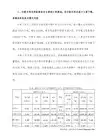
“课后训练”参考答案第一章主要概念供应链是围绕核心企业,通过对信息流、物流、资金流的控制,从采购原材料开始,制成中间产品以及最终产品,最后由销售网络把产品送到消费者手中的将供应商、制造商、分销商、零售商、直到最终用户连成的一个整体的增值网链结构单元供应链由一家企业的直接供货商和直接客户组成,包括了从需到供的循环。
它是供应链的最基本模式产业供应链(extended supply chain)由单元供应链组成,是企业联合其他上下游企业,通过联盟和外包等各种合作方式建立一条经济利益相关、业务关系紧密、优势互补的产业供需关系网链,企业充分利用产业供应链上的资源来适应新的竞争环境,实现合作优化,共同增强竞争力。
全球供应链是在全球范围内组合供应链,是企业根据需要在世界各地选取最有竞争力的合作伙伴,结成全球供应链网络,以实现该供应链的最优化供应链管理是为满足服务水平要求,将供应商、生产商、销售商、物流商到最终用户结成网链来组织生产与销售商品,并通过商流、物流、信息流、资金流系统设计、计划、运行和控制等活动达到降低系统总成本的预期目的,它是供应链商流、物流、信息流、资金流以及合作者关系等规划、设计、运营、控制过程进行一体化的集成管理思想、方法和技术体系一体化物流是指原料、半成品和成品的生产、供应、销售环节结合成有机整体,进行系统计划与协调的活动重点实务企业供应链结构分析:能够根据实际运作绘制企业供应链结构;效率型供应链、反应型供应链与功能性产品和创新性产品的匹配:能够明确效率型供应链与功能性产品、反应型供应链和创新性产品的匹配关系。
习题与训练一、判断题1.√2.×3.√4.√5.×二、选择题1.A2.A3.D4.D5.A三、简答题1.供应链有发散网结构、会聚网结构、T形网结构等三种结构。
供应链主要具有以下特征:(1)全局性;(2)复杂性;(3)动态性;(4)交叉性;(5)增值性;(6)面向用户需求。
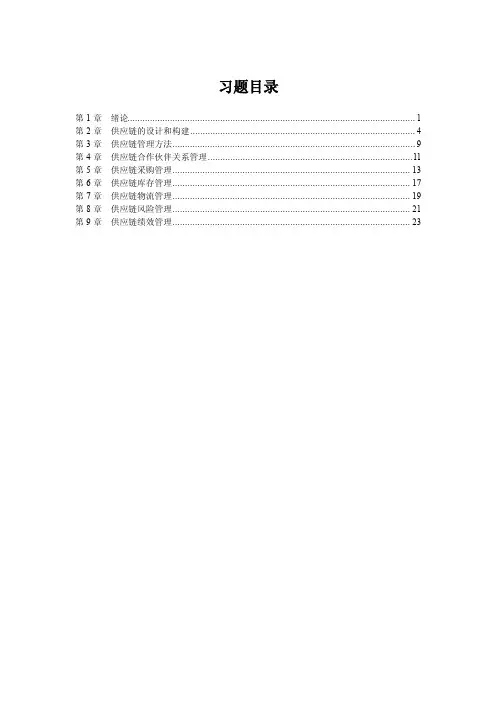
习题目录第1章绪论 (1)第2章供应链的设计和构建 (4)第3章供应链管理方法 (9)第4章供应链合作伙伴关系管理 (11)第5章供应链采购管理 (13)第6章供应链库存管理 (17)第7章供应链物流管理 (19)第8章供应链风险管理 (21)第9章供应链绩效管理 (23)第1章绪论【习题答案】1.选择题(1)B(2)D(3)B(4)A(5)B(6)C(7)D(8)A(9)C2.简答题(1)供应链的概念。
答:供应链是指围绕核心企业,通过对信息流、物流、资金流的控制,从采购原材料开始,制成中间产品以及最终产品,最后由销售网络把产品送到消费者手中的将供应商、制造商、分销商、零售商、直到最终用户连成一个整体的网链结构和模式。
(2)供应链包括哪4个流程?答:供应链一般包括物资流通、商业流通、信息流通、资金流通4个流程。
(3)简述推式供应链和拉式供应链的优缺点。
答:推式供应链的优点:能够稳定供应链的生产符合,提高机器设备利用率,缩短提前期,增加交货可能性。
缺点:需要有较多的原材料、在制品和制成品库存,库存占用的流动资金较大,当市场需求发生变化时,企业应变能力较弱。
拉式供应链的的优点:大大降低各类库存和流动资金占用,减少库存变质和失效的风险。
缺点:将面对能否及时获取资源和及时交货以满足市场需求的风险。
(4)供应链有哪些特征?答:供应链有4个主要特性:复杂性、动态性、用户需求驱动性及交叉性。
(5)陈述供应链管理的概念。
答:供应链由原材料零部件供应商、生产商、批发经销商、用户、运输商等一系列企业组成。
原材料零部件依次通过“链”中的每个企业,逐步变成产品,产品再通过一系列流通配送环节,最后交到最终用户手中,这一系列的活动就构成了一个完整供应链的全部活动。
(6)供应链管理的主要内容有哪几方面?答:供应链管理的主要内容有:物流网络职能管理、物流信息流管理、供应链流程管理以及供应链关系管理。
(7)简述推拉式供应链管理模式的内涵及其包含哪两种模式。
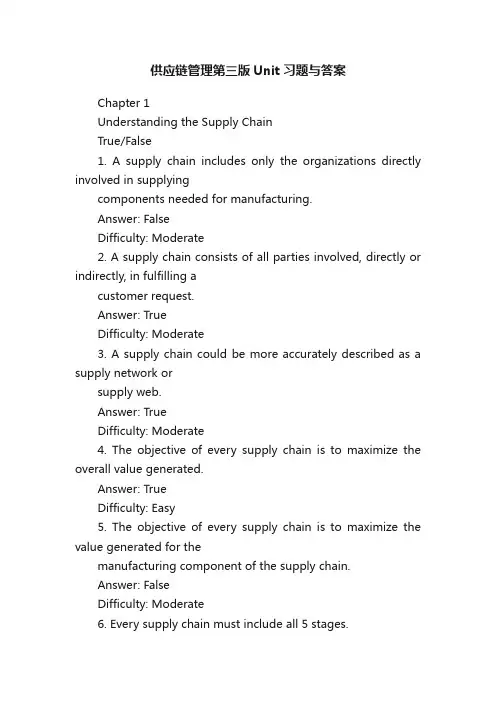
供应链管理第三版Unit习题与答案Chapter 1Understanding the Supply ChainTrue/False1. A supply chain includes only the organizations directly involved in supplyingcomponents needed for manufacturing.Answer: FalseDifficulty: Moderate2. A supply chain consists of all parties involved, directly or indirectly, in fulfilling acustomer request.Answer: TrueDifficulty: Moderate3. A supply chain could be more accurately described as a supply network orsupply web.Answer: TrueDifficulty: Moderate4. The objective of every supply chain is to maximize the overall value generated.Answer: TrueDifficulty: Easy5. The objective of every supply chain is to maximize the value generated for themanufacturing component of the supply chain.Answer: FalseDifficulty: Moderate6. Every supply chain must include all 5 stages.Answer: FalseDifficulty: Easy7. The cycle view of a supply chain holds that the processes in a supply chain aredivided into a series of activities performed at the interface between successivestages.Answer: TrueDifficulty: Moderate8. The cycle view of a supply chain holds that the processes in a supply chain aredivided into 2 categories depending on whether they are initiated in response toor in anticipation of customer orders.Answer: FalseDifficulty: Moderate9. The push/pull view of a supply chain holds that the processes in a supply chainare divided into 2 categories depending on whether they are initiated in responseto or in anticipation of customer orders.Answer: TrueDifficulty: Easy10. The push/pull view of a supply chain holds that the processes in a supply chainare divided into a series of activities performed at the interface betweensuccessive stages.Answer: FalseDifficulty: Easy11. The objective of the customer arrival process is to maximize the conversion ofcustomer arrivals to customer orders.Answer: TrueDifficulty: Moderate12. The objective of the customer arrival process is to ensure thatorders are quicklyand accurately entered and communicated to other affected supply chainprocesses.Answer: FalseDifficulty: Moderate13. The objective of customer order entry is to ensure that orders are quickly andaccurately entered and communicated to other affected supply chain processes.Answer: TrueDifficulty: Moderate14. The objective of customer order entry is to maintain a record of product receiptand complete payment.Answer: FalseDifficulty: Hard15. The replenishment cycle occurs at the retailer/distributor interface.Answer: TrueDifficulty: Hard16. The replenishment cycle occurs at the distributor/manufacturer interface.Answer: FalseDifficulty: Hard17. The replenishment cycle is initiated when a supermarket runs out of stock of aparticular item.Answer: TrueDifficulty: Hard18. The replenishment cycle is initiated when customers load items intended forpurchase into their carts.Answer: FalseDifficulty: Hard19. The manufacturing cycle occurs at the distributor/manufacturer interface.Answer: TrueDifficulty: Moderate20. The manufacturing cycle occurs at the manufacturer/supplier interface.Answer: FalseDifficulty: Moderate21. The production scheduling process in the manufacturing cycle is similar to theorder entry process in the replenishment cycle.Answer: TrueDifficulty: Hard22. The production scheduling process in the manufacturing cycle is similar to theorder fulfillment process in the replenishment cycle.Answer: FalseDifficulty: Hard23. The procurement cycle occurs at the manufacturer/supplier interface.Answer: TrueDifficulty: Easy24. The procurement cycle occurs at the retailer/distributor interface.Answer: FalseDifficulty: Easy25. The cycle view of the supply chain is useful when considering operationaldecisions, because it specifies the roles and responsibilities of each member ofthe supply chain.Answer: TrueDifficulty: Moderate26. The cycle view of the supply chain is useful when considering operationaldecisions, because it categorizes processes based on whether they are initiatedin response to or in anticipation of customer orders.Answer: FalseDifficulty: Moderate27. The push/pull view of the supply chain is useful when considering strategicdecisions relating to supply chain design, because it categorizes processesbased on whether they are initiated in response to or in anticipation of customerorders.Answer: TrueDifficulty: Moderate28. The push/pull view of the supply chain is useful when considering strategicdecisions relating to supply chain design, because it specifies the roles andresponsibilities of each member of the supply chain.Answer: FalseDifficulty: Moderate29. Pull processes may also be referred to as reactive processes.Answer: TrueDifficulty: Easy30. Pull processes may also be referred to as speculative processes.Answer: FalseDifficulty: Easy31. Push processes may also be referred to as speculative processes.Answer: TrueDifficulty: Easy32. Push processes may also be referred to as reactive processes.Answer: FalseDifficulty: Easy33. All supply chain activities within a firm belong to one of three macro processes 每CRM, ISCM and SRM.Answer: TrueDifficulty: Easy34. There is a close connection between the design and management of supplychain flows and the success of a supply chain.Answer: TrueDifficulty: EasyMultiple Choice1. Which of the following is not a stage within a typical supply chain?a. Customersb. Retailersc. Wholesalers/Distributorsd. Manufacturerse. All of the above are stages within a typical supply chain.Answer: eDifficulty: Easy2. Which of the following is not a stage within a typical supply chain?a. Customersb. Retailersc. Wholesalers/Distributorsd. Merchandiserse. Component/Raw material suppliersAnswer: dDifficulty: Easy3. Supply chain profitability isa. not correlated to the value generated by the various stages of the supplychain.b. the total profit to be shared across all supply chain stages.c. the difference between the revenue generated from the customer and theoverall cost across the supply chain.d. the total revenue generated by the distributor stage of the supply chain.e. b and c onlyAnswer: eDifficulty: Difficult4. Successful supply chain management requires which of the following decisionphases?a. supply chain strategy/designb. supply chain planningc. supply chain operationd. all of the abovee. a and b onlyAnswer: dDifficulty: Moderate5. The decision phases in a supply chain includea. production scheduling.b. customer relationship management.c. supply chain operation.d. supply chain orientation.e. all of the aboveAnswer: cDifficulty: Moderate6. The cycle view of a supply chain holds thata. the processes in a supply chain are divided into 2 categories.b. the processes in a supply chain are divided into a series ofactivitiesperformed at the interface between successive stages.c. all processes in a supply chain are initiated in response to a customerorder.d. all processes in a supply chain are performed in anticipation of customerorders.e. None of the above are true.Answer: bDifficulty: Moderate7. The push/pull view of a supply chain holds thata. the processes in a supply chain are divided into a series of activitiesperformed at the interface between successive stages.b. all processes in a supply chain are initiated in response to a customerorder.c. all response in a supply chain are performed in anticipation of customerorders. d. the processes in a supply chain are divided into 2 categories dependingon whether they are initiated in response to or in anticipation of customerorders.e. None of the above are true.Answer: dDifficulty: Moderate8. Which of the following is not a cycle in the supply chain cycle view?a. Analysis cycleb. Customer order cyclec. Replenishment cycled. Manufacturing cyclee. Procurement cycleAnswer: aDifficulty: Moderate9. Which of the following is not a cycle in the supply chain cycle view?a. Customer order cycleb. Replenishment cyclec. Manufacturing cycled. Procurement cyclee. All of the above are part of the supply chain cycle view.Answer: eDifficulty: Moderate10. The customer order cycle occurs at thea. customer/retailer interface.b. retailer/distributor interface.c. distributor/manufacturer interface.d. manufacturer/supplier interface.e. none of the aboveAnswer: aDifficulty: Easy11. Which of the following is not a process in the customer order cycle?a. Customer arrivalb. Customer qualificationc. Customer order entryd. Customer order fulfillmente. Customer order receivingAnswer: bDifficulty: Moderate12. Customer arrival refers toa. the point in time when the customer has access to choices and makes adecision regarding a purchase.b. the customer informing the retailer of what they want to purchase and theretailer allocating product to the customer.c. the process where product is prepared and sent to the customer.d. the process where the customer receives the product and takesownership. e. none of the aboveAnswer: aDifficulty: Moderate13. The objective of the customer arrival process is toa. get the correct orders to customers by the promised due date at thelowest possible cost.b. maintain a record of product receipt and complete payment.c. maximize the conversion of customer arrivals to customer orders.d. ensure that orders are quickly and accurately entered and communicatedto other affected supply chain processes.e. none of the aboveAnswer: cDifficulty: Easy14. Customer order entry isa. the point in time when the customer has access to choices and makes adecision regarding a purchase.b. the customer informing the retailer of what they want to purchase and theretailer allocating product to the customer.c. the process where product is prepared and sent to the customer.d. the process where the customer receives the product and takesownership.e. none of the aboveAnswer: bDifficulty: Moderate15. The objective of customer order entry is toa. get the correct orders to customers by the promised due date at thelowest possible cost.b. maintain a record of product receipt and complete payment.c. maximize the conversion of customer arrivals to customer orders.d. ensure that orders are quickly and accurately entered and communicatedto other affected supply chain processes.e. none of the aboveDifficulty: Easy16. Customer order fulfillment refers toa. the point in time when the customer has access to choices and makes adecision regarding a purchase.b. the customer informing the retailer of what they want to purchase and theretailer allocating product to the customer.c. the process where product is prepared and sent to the customer.d. the process where the customer receives the product and takesownership.e. none of the aboveAnswer: cDifficulty: Moderate17. The objective of customer order fulfillment is toa. get the correct orders to customers by the promised due date at thelowest possible cost.b. maintain a record of product receipt and complete payment.c. maximize the conversion of customer arrivals to customer orders.d. ensure that orders are quickly and accurately entered and communicatedto other affected supply chain processes.e. none of the aboveDifficulty: Easy18. Customer order receiving isa. the point in time when the customer has access to choices and makes adecision regarding a purchase.b. the customer informing the retailer of what they want to purchase and theretailer allocates product to the customer.c. the process where product is prepared and sent to the customer.d. the process where the customer receives the product and takes ownership.e. none of the aboveAnswer: dDifficulty: Moderate19. The replenishment cycle occurs at thea. customer/retailer interface.b. retailer/distributor interface.c. distributor/manufacturer interface.d. manufacturer/supplier interface.e. none of the aboveAnswer: bDifficulty: Easy20. The processes involved in the replenishment cycle includea. retail order receiving.b. retail order entry.c. retail order trigger.d. retail order fulfillment.。
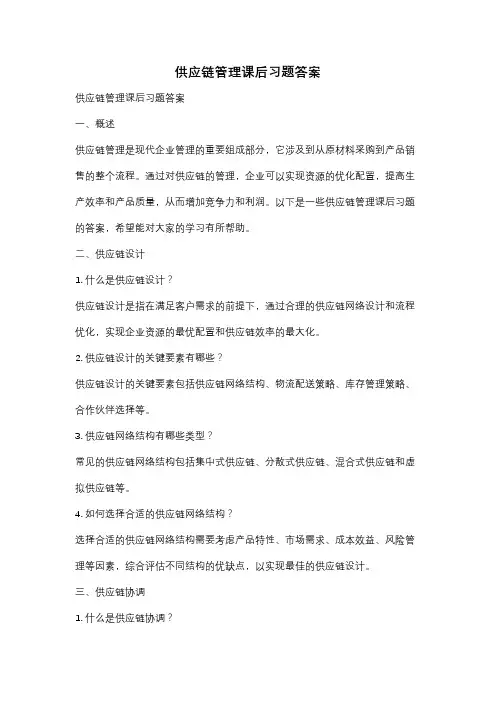
供应链管理课后习题答案供应链管理课后习题答案一、概述供应链管理是现代企业管理的重要组成部分,它涉及到从原材料采购到产品销售的整个流程。
通过对供应链的管理,企业可以实现资源的优化配置,提高生产效率和产品质量,从而增加竞争力和利润。
以下是一些供应链管理课后习题的答案,希望能对大家的学习有所帮助。
二、供应链设计1. 什么是供应链设计?供应链设计是指在满足客户需求的前提下,通过合理的供应链网络设计和流程优化,实现企业资源的最优配置和供应链效率的最大化。
2. 供应链设计的关键要素有哪些?供应链设计的关键要素包括供应链网络结构、物流配送策略、库存管理策略、合作伙伴选择等。
3. 供应链网络结构有哪些类型?常见的供应链网络结构包括集中式供应链、分散式供应链、混合式供应链和虚拟供应链等。
4. 如何选择合适的供应链网络结构?选择合适的供应链网络结构需要考虑产品特性、市场需求、成本效益、风险管理等因素,综合评估不同结构的优缺点,以实现最佳的供应链设计。
三、供应链协调1. 什么是供应链协调?供应链协调是指通过信息共享、合作伙伴关系管理、业务流程优化等手段,实现供应链各环节之间的协同和协作,以提高供应链整体效能。
2. 供应链协调的重要性是什么?供应链协调可以减少信息滞后、降低库存水平、提高交付准确率,从而提高供应链的灵活性、响应速度和客户满意度。
3. 如何实现供应链协调?实现供应链协调需要建立有效的沟通机制、共享信息平台,加强合作伙伴之间的信任和合作,同时优化业务流程和决策机制。
四、供应链风险管理1. 什么是供应链风险管理?供应链风险管理是指通过识别、评估和应对供应链中的各种风险,以保障供应链的稳定运行和业务连续性。
2. 常见的供应链风险有哪些?常见的供应链风险包括市场需求波动、供应商倒闭、物流延误、自然灾害等。
3. 如何进行供应链风险管理?供应链风险管理需要建立风险识别和评估机制,制定相应的风险应对策略,同时建立灵活的供应链网络和备份计划,以应对不同的风险情况。
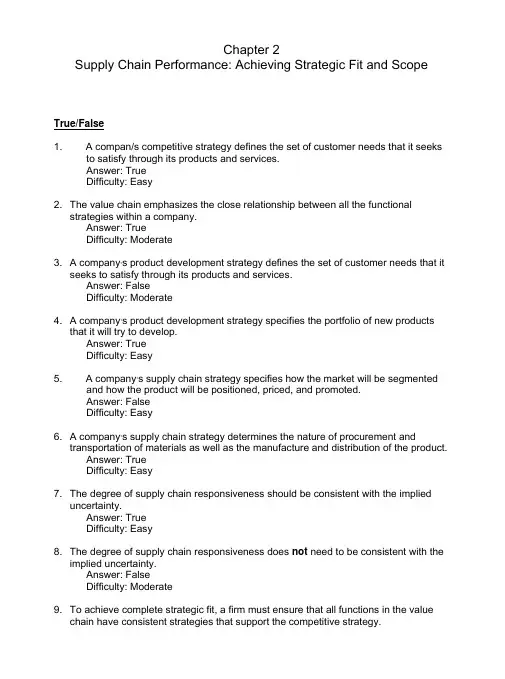
Chapter 2Supply Chain Performance: Achieving Strategic Fit and ScopeTrue/False1. A compan/s competitive strategy defines the set of customer needs that it seeksto satisfy through its products and services.Answer: TrueDifficulty: Easy2. The value chain emphasizes the close relationship between all the functionalstrategies within a company.Answer: TrueDifficulty: Moderate3. A company,s product development strategy defines the set of customer needs that itseeks to satisfy through its products and services.Answer: FalseDifficulty: Moderate4. A company,s product development strategy specifies the portfolio of new productsthat it will try to develop.Answer: TrueDifficulty: Easy5. A company,s supply chain strategy specifies how the market will be segmentedand how the product will be positioned, priced, and promoted.Answer: FalseDifficulty: Easy6. A company,s supply chain strategy determines the nature of procurement andtransportation of materials as well as the manufacture and distribution of the product.Answer: TrueDifficulty: Easy7. The degree of supply chain responsiveness should be consistent with the implieduncertainty.Answer: TrueDifficulty: Easy8. The degree of supply chain responsiveness does not need to be consistent with theimplied uncertainty.Answer: FalseDifficulty: Moderate9. To achieve complete strategic fit, a firm must ensure that all functions in the valuechain have consistent strategies that support the competitive strategy.Answer: TrueDifficulty: Moderate10. To achieve complete strategic fit, a firm must ensure that all functions in the valuechain have diverse strategies that support functional goals.Answer: FalseDifficulty: Moderate11. Because demand and supply characteristics change, the supply chain strategy mustchange over the product life cycle if a company is to continue achieving strategic fit.Answer: TrueDifficulty: Easy12. The supply chain strategy must be established at the beginning of the product lifecycle and not changed if a company is to continue achieving strategic fit.Answer: FalseDifficulty: Easy13. To retain strategic fit, supply chain strategy must be adjusted over the life cycle of aproduct and as the competitive landscape changes.Answer: TrueDifficulty: Moderate14. The intercompany scope of strategic fit is essential today because the competitiveplaying field has shifted from company versus company to supply chain versussupply chain.Answer: TrueDifficulty: Moderate15. The intercompany scope of strategic fit is no longer relevant today because thecompetitive playing field has shifted from company versus company to supply chain versus supply chain.Answer: FalseDifficulty: Easy16. The intercompany scope of strategic fit requires firms to evaluate every action in thecontext of the entire supply chain.Answer: TrueDifficulty: Moderate17. There is a close connection between the design and management of supply chainflows and the success of a supply chain.Answer: TrueDifficulty: EasyEssav/Problems1. Discuss the two keys to the success or failure of a company.Answer. A company,s success or failure is thus closely linked to the followingkeys:1. The competitive strategy and all functional strategies must fit together to forma coordinated overall strategy. Each functional strategy must support otherfunctional strategies and help a firm reach its competitive strategy goal.2. The different functions in a company must appropriately structure theirprocesses and resources to be able to execute these strategies successfully.Difficulty: Hard答:一个公司的胜利或失败,因此是亲密相关的下列键:K竞争战略和职能战略都必需符合共同形成•个协调的总体战略。
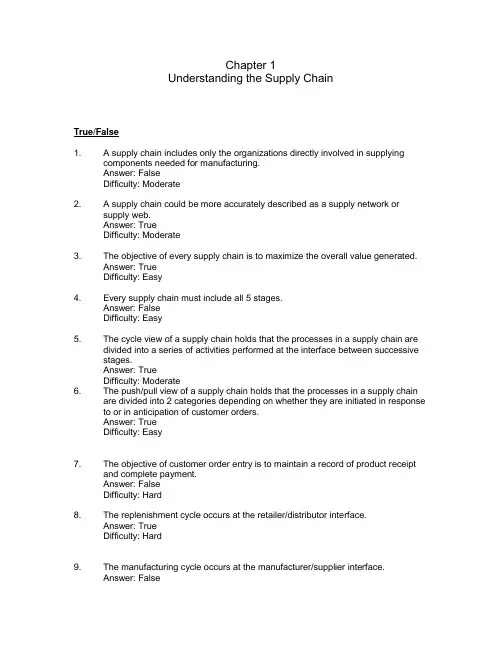
Chapter 1Understanding the Supply ChainTrue/False1. A supply chain includes only the organizations directly involved in supplyingcomponents needed for manufacturing.Answer: FalseDifficulty: Moderate2. A supply chain could be more accurately described as a supply network orsupply web.Answer: TrueDifficulty: Moderate3. The objective of every supply chain is to maximize the overall value generated.Answer: TrueDifficulty: Easy4. Every supply chain must include all 5 stages.Answer: FalseDifficulty: Easy5. The cycle view of a supply chain holds that the processes in a supply chain aredivided into a series of activities performed at the interface between successivestages.Answer: TrueDifficulty: Moderate6. The push/pull view of a supply chain holds that the processes in a supply chainare divided into 2 categories depending on whether they are initiated in response to or in anticipation of customer orders.Answer: TrueDifficulty: Easy7. The objective of customer order entry is to maintain a record of product receiptand complete payment.Answer: FalseDifficulty: Hard8. The replenishment cycle occurs at the retailer/distributor interface.Answer: TrueDifficulty: Hard9. The manufacturing cycle occurs at the manufacturer/supplier interface.Answer: FalseDifficulty: Moderate10. The procurement cycle occurs at the manufacturer/supplier interface.Answer: TrueDifficulty: Easy11. The cycle view of the supply chain is useful when considering operationaldecisions, because it specifies the roles and responsibilities of each member of the supply chain.Answer: TrueDifficulty: Moderate12. The push/pull view of the supply chain is useful when considering strategicdecisions relating to supply chain design, because it categorizes processesbased on whether they are initiated in response to or in anticipation of customer orders.Answer: TrueDifficulty: Moderate13. Pull processes may also be referred to as reactive processes.Answer: TrueDifficulty: Easy14. Pull processes may also be referred to as speculative processes.Answer: FalseDifficulty: Easy15. All supply chain activities within a firm belong to one of three macro processes –CRM, ISCM and SRM.Answer: TrueDifficulty: Easy16. There is a close connection between the design and management of supplychain flows and the success of a supply chain.Answer: TrueDifficulty: EasyEssay/Problems1. Explain the 3 decision phases (categories) that must be made in a successfulsupply chain.Answ er: The 3 decision phases that occur within a supply chain are supply chain strategy (or design), supply chain planning and supply chain operation. Decisions relate to the flow of information, product and funds. The difference betweencategories depends upon the frequency of each decision and the time frame over which it has an impact. During the supply chain strategy phase, a companydetermines what the chain’s configurations will be, how resources will beallocated, and what processes each stage will perform. This will establish thestructure of the supply chain for several years. Supply chain planning deals with decisions with a time frame from 3 months up to a year. The planning phasemust work within the constraints established in the strategy phase. Planningdecisions include which markets to supply from which locations, subcontractingof manufacturing, inventory policies and timing and size of marketing promotions.The supply chain operation phase operates on a weekly or daily time horizon and deals with decisions concerning individual customer orders.Difficulty: Hard答:决策的3阶段发生在一个供应链的供应链战略(或设计),供应链与供应链运作。
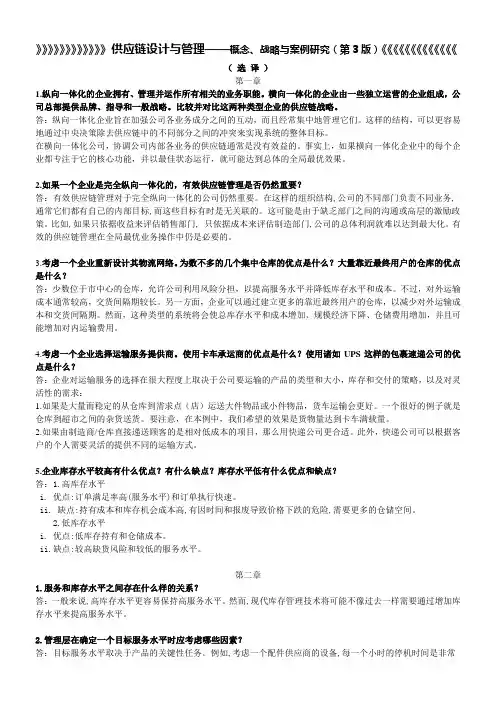
》》》》》》》》》》》》供应链设计与管理——概念、战略与案例研究(第3版)《《《《《《《《《《《《《(选译)第一章1.纵向一体化的企业拥有、管理并运作所有相关的业务职能。
横向一体化的企业由一些独立运营的企业组成,公司总部提供品牌、指导和一般战略。
比较并对比这两种类型企业的供应链战略。
答:纵向一体化企业旨在加强公司各业务成分之间的互动,而且经常集中地管理它们。
这样的结构,可以更容易地通过中央决策除去供应链中的不同部分之间的冲突来实现系统的整体目标。
在横向一体化公司,协调公司内部各业务的供应链通常是没有效益的。
事实上,如果横向一体化企业中的每个企业都专注于它的核心功能,并以最佳状态运行,就可能达到总体的全局最优效果。
2.如果一个企业是完全纵向一体化的,有效供应链管理是否仍然重要?答:有效供应链管理对于完全纵向一体化的公司仍然重要。
在这样的组织结构,公司的不同部门负责不同业务,通常它们都有自己的内部目标,而这些目标有时是无关联的。
这可能是由于缺乏部门之间的沟通或高层的激励政策。
比如,如果只依据收益来评估销售部门, 只依据成本来评估制造部门,公司的总体利润就难以达到最大化。
有效的供应链管理在全局最优业务操作中仍是必要的。
3.考虑一个企业重新设计其物流网络。
为数不多的几个集中仓库的优点是什么?大量靠近最终用户的仓库的优点是什么?答:少数位于市中心的仓库,允许公司利用风险分担,以提高服务水平并降低库存水平和成本。
不过,对外运输成本通常较高,交货间隔期较长。
另一方面,企业可以通过建立更多的靠近最终用户的仓库,以减少对外运输成本和交货间隔期。
然而,这种类型的系统将会使总库存水平和成本增加、规模经济下降、仓储费用增加,并且可能增加对内运输费用。
4.考虑一个企业选择运输服务提供商。
使用卡车承运商的优点是什么?使用诸如UPS这样的包裹速递公司的优点是什么?答:企业对运输服务的选择在很大程度上取决于公司要运输的产品的类型和大小,库存和交付的策略,以及对灵活性的需求:1.如果是大量而稳定的从仓库到需求点(店)运送大件物品或小件物品,货车运输会更好。
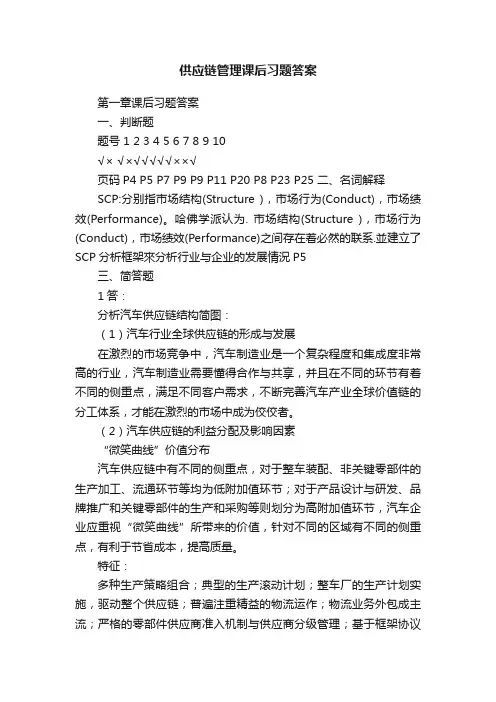
供应链管理课后习题答案第一章课后习题答案一、判断题题号 1 2 3 4 5 6 7 8 9 10√× √×√√√√√××√页码P4 P5 P7 P9 P9 P11 P20 P8 P23 P25 二、名词解释SCP:分别指市场结构(Structure ),市场行为(Conduct),市场绩效(Performance)。
哈佛学派认为. 市场结构(Structure ),市场行为(Conduct),市场绩效(Performance)之间存在着必然的联系.並建立了SCP分析框架來分析行业与企业的发展情況P5三、简答题1答:分析汽车供应链结构简图:(1)汽车行业全球供应链的形成与发展在激烈的市场竞争中,汽车制造业是一个复杂程度和集成度非常高的行业,汽车制造业需要懂得合作与共享,并且在不同的环节有着不同的侧重点,满足不同客户需求,不断完善汽车产业全球价值链的分工体系,才能在激烈的市场中成为佼佼者。
(2)汽车供应链的利益分配及影响因素“微笑曲线”价值分布汽车供应链中有不同的侧重点,对于整车装配、非关键零部件的生产加工、流通环节等均为低附加值环节;对于产品设计与研发、品牌推广和关键零部件的生产和采购等则划分为高附加值环节,汽车企业应重视“微笑曲线”所带来的价值,针对不同的区域有不同的侧重点,有利于节省成本,提高质量。
特征:多种生产策略组合;典型的生产滚动计划;整车厂的生产计划实施,驱动整个供应链;普遍注重精益的物流运作;物流业务外包成主流;严格的零部件供应商准入机制与供应商分级管理;基于框架协议下的全球化采购;汽车售后供应链体系备受关注。
汽车产业发展新趋势汽车产业发展呈现规模化、集群化发展趋势,产业集群化使产业链纵向延伸发展,同时提高了与相关产业进行横向竞争与合作的效率2、答:分析服装供应链结构简图:先分析服装供应链的工艺流程,再分析服装供应链的类型。
服装供应链有四种主要类型的企业:(1)单纯的生产加工企业(2)自有品牌的“虚拟企业”(3)供、产、销一体化的企业(4)服装贸易公司特征:(1)服装产品的生命周期短(2)服装消费需求变动性大(3)服装消费需求的可预测性低(4)服装购买的冲动性高(5)服装产品被模仿的情况严重P14-15发展趋势:(1)产品个性化需求增大消费能力、消费心理与社会的进步三个因素,共同催生了个性化定制这个基于人自身表达诉求的概念。
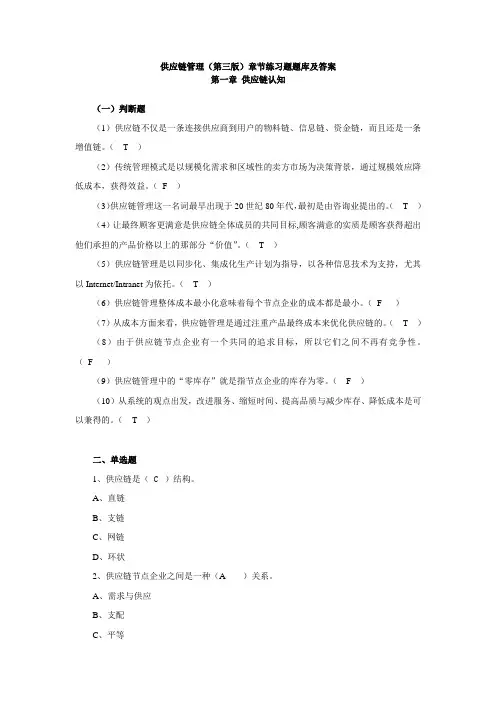
供应链管理(第三版)章节练习题题库及答案第一章供应链认知(一)判断题(1)供应链不仅是一条连接供应商到用户的物料链、信息链、资金链,而且还是一条增值链。
(T )(2)传统管理模式是以规模化需求和区域性的卖方市场为决策背景,通过规模效应降低成本,获得效益。
( F )(3)供应链管理这一名词最早出现于20世纪80年代,最初是由咨询业提出的。
(T )(4)让最终顾客更满意是供应链全体成员的共同目标,顾客满意的实质是顾客获得超出他们承担的产品价格以上的那部分“价值”。
(T )(5)供应链管理是以同步化、集成化生产计划为指导,以各种信息技术为支持,尤其以Internet/Intranet为依托。
(T )(6)供应链管理整体成本最小化意味着每个节点企业的成本都是最小。
( F )(7)从成本方面来看,供应链管理是通过注重产品最终成本来优化供应链的。
(T )(8)由于供应链节点企业有一个共同的追求目标,所以它们之间不再有竞争性。
(F )(9)供应链管理中的“零库存”就是指节点企业的库存为零。
( F )(10)从系统的观点出发,改进服务、缩短时间、提高品质与减少库存、降低成本是可以兼得的。
(T )二、单选题1、供应链是(C)结构。
A、直链B、支链C、网链D、环状2、供应链节点企业之间是一种(A )关系。
A、需求与供应B、支配C、平等D、利益3、供应链管理因企业战略和适应市场需求变化的需要,链上节点企业需要动态地更新,这就使得供应链具有明显的(B )。
A、复杂性B、动态性C、交叉性D、灵活性4、从20世纪80年代初到20世纪90年代初供应链管理处于(A )。
A、初级阶段B、发展阶段C、成熟阶段D、建设阶段5、按照道格拉斯·兰伯特的思想,企业主动召回有问题的已售商品,属于供应链业务流程的( B )程序?A、订单配送B、反向物流(回流)C、需求管理D、制造流程管理三、多选题1、传统“纵向一体化”管理模式存在的弊端有(ABCD )。
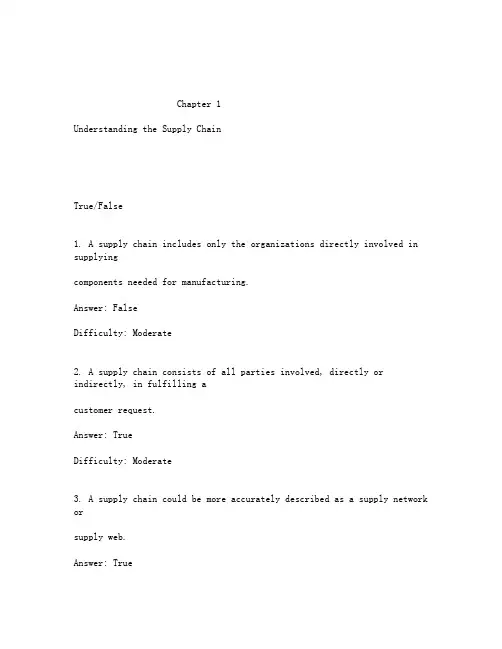
Chapter 1Understanding the Supply ChainTrue/False1. A supply chain includes only the organizations directly involved in supplyingcomponents needed for manufacturing.Answer: FalseDifficulty: Moderate2. A supply chain consists of all parties involved, directly or indirectly, in fulfilling acustomer request.Answer: TrueDifficulty: Moderate3. A supply chain could be more accurately described as a supply network orsupply web.Answer: TrueDifficulty: Moderate4. The objective of every supply chain is to maximize the overall value generated.Answer: TrueDifficulty: Easy5. The objective of every supply chain is to maximize the value generated for themanufacturing component of the supply chain.Answer: FalseDifficulty: Moderate6. Every supply chain must include all 5 stages.Answer: FalseDifficulty: Easy7. The cycle view of a supply chain holds that the processes in a supply chain aredivided into a series of activities performed at the interface between successivestages.Answer: TrueDifficulty: Moderate8. The cycle view of a supply chain holds that the processes in a supply chain aredivided into 2 categories depending on whether they are initiated in response toor in anticipation of customer orders.Answer: FalseDifficulty: Moderate9. The push/pull view of a supply chain holds that the processes in a supply chainare divided into 2 categories depending on whether they are initiated in responseto or in anticipation of customer orders.Answer: TrueDifficulty: Easy10. The push/pull view of a supply chain holds that the processes in a supply chainare divided into a series of activities performed at the interface betweensuccessive stages.Answer: FalseDifficulty: Easy11. The objective of the customer arrival process is to maximize the conversion ofcustomer arrivals to customer orders.Answer: TrueDifficulty: Moderate12. The objective of the customer arrival process is to ensure thatorders are quicklyand accurately entered and communicated to other affected supply chainprocesses.Answer: FalseDifficulty: Moderate13. The objective of customer order entry is to ensure that orders are quickly andaccurately entered and communicated to other affected supply chain processes.Answer: TrueDifficulty: Moderate14. The objective of customer order entry is to maintain a record of product receiptand complete payment.Answer: FalseDifficulty: Hard15. The replenishment cycle occurs at the retailer/distributor interface.Answer: TrueDifficulty: Hard16. The replenishment cycle occurs at the distributor/manufacturer interface.Answer: FalseDifficulty: Hard17. The replenishment cycle is initiated when a supermarket runs out of stock of aparticular item.Answer: TrueDifficulty: Hard18. The replenishment cycle is initiated when customers load items intended forpurchase into their carts.Answer: FalseDifficulty: Hard19. The manufacturing cycle occurs at the distributor/manufacturer interface.Answer: TrueDifficulty: Moderate20. The manufacturing cycle occurs at the manufacturer/supplier interface.Answer: FalseDifficulty: Moderate21. The production scheduling process in the manufacturing cycle is similar to theorder entry process in the replenishment cycle.Answer: TrueDifficulty: Hard22. The production scheduling process in the manufacturing cycle is similar to theorder fulfillment process in the replenishment cycle.Answer: FalseDifficulty: Hard23. The procurement cycle occurs at the manufacturer/supplier interface.Answer: TrueDifficulty: Easy24. The procurement cycle occurs at the retailer/distributor interface.Answer: FalseDifficulty: Easy25. The cycle view of the supply chain is useful when considering operationaldecisions, because it specifies the roles and responsibilities of each member ofthe supply chain.Answer: TrueDifficulty: Moderate26. The cycle view of the supply chain is useful when considering operationaldecisions, because it categorizes processes based on whether they are initiatedin response to or in anticipation of customer orders.Answer: FalseDifficulty: Moderate27. The push/pull view of the supply chain is useful when considering strategicdecisions relating to supply chain design, because it categorizes processesbased on whether they are initiated in response to or in anticipation of customerorders.Answer: TrueDifficulty: Moderate28. The push/pull view of the supply chain is useful when considering strategicdecisions relating to supply chain design, because it specifies the roles andresponsibilities of each member of the supply chain.Answer: FalseDifficulty: Moderate29. Pull processes may also be referred to as reactive processes.Answer: TrueDifficulty: Easy30. Pull processes may also be referred to as speculative processes.Answer: FalseDifficulty: Easy31. Push processes may also be referred to as speculative processes.Answer: TrueDifficulty: Easy32. Push processes may also be referred to as reactive processes.Answer: FalseDifficulty: Easy33. All supply chain activities within a firm belong to one of three macro processes 每CRM, ISCM and SRM.Answer: TrueDifficulty: Easy34. There is a close connection between the design and management of supplychain flows and the success of a supply chain.Answer: TrueDifficulty: EasyMultiple Choice1. Which of the following is not a stage within a typical supply chain?a. Customersb. Retailersc. Wholesalers/Distributorsd. Manufacturerse. All of the above are stages within a typical supply chain.Answer: eDifficulty: Easy2. Which of the following is not a stage within a typical supply chain?a. Customersb. Retailersc. Wholesalers/Distributorsd. Merchandiserse. Component/Raw material suppliersAnswer: dDifficulty: Easy3. Supply chain profitability isa. not correlated to the value generated by the various stages of the supplychain.b. the total profit to be shared across all supply chain stages.c. the difference between the revenue generated from the customer and theoverall cost across the supply chain.d. the total revenue generated by the distributor stage of the supply chain.e. b and c onlyAnswer: eDifficulty: Difficult4. Successful supply chain management requires which of the following decisionphases?a. supply chain strategy/designb. supply chain planningc. supply chain operationd. all of the abovee. a and b onlyAnswer: dDifficulty: Moderate5. The decision phases in a supply chain includea. production scheduling.b. customer relationship management.c. supply chain operation.d. supply chain orientation.e. all of the aboveAnswer: cDifficulty: Moderate6. The cycle view of a supply chain holds thata. the processes in a supply chain are divided into 2 categories.b. the processes in a supply chain are divided into a series of activitiesperformed at the interface between successive stages.c. all processes in a supply chain are initiated in response to a customerorder.d. all processes in a supply chain are performed in anticipation of customerorders.e. None of the above are true.Answer: bDifficulty: Moderate7. The push/pull view of a supply chain holds thata. the processes in a supply chain are divided into a series of activitiesperformed at the interface between successive stages.b. all processes in a supply chain are initiated in response to a customerorder.c. all response in a supply chain are performed in anticipation of customerorders. d. the processes in a supply chain are divided into 2 categories dependingon whether they are initiated in response to or in anticipation of customerorders.e. None of the above are true.Answer: dDifficulty: Moderate8. Which of the following is not a cycle in the supply chain cycle view?a. Analysis cycleb. Customer order cyclec. Replenishment cycled. Manufacturing cyclee. Procurement cycleAnswer: aDifficulty: Moderate9. Which of the following is not a cycle in the supply chain cycle view?a. Customer order cycleb. Replenishment cyclec. Manufacturing cycled. Procurement cyclee. All of the above are part of the supply chain cycle view.Answer: eDifficulty: Moderate10. The customer order cycle occurs at thea. customer/retailer interface.b. retailer/distributor interface.c. distributor/manufacturer interface.d. manufacturer/supplier interface.e. none of the aboveAnswer: aDifficulty: Easy11. Which of the following is not a process in the customer order cycle?a. Customer arrivalb. Customer qualificationc. Customer order entryd. Customer order fulfillmente. Customer order receivingAnswer: bDifficulty: Moderate12. Customer arrival refers toa. the point in time when the customer has access to choices and makes adecision regarding a purchase.b. the customer informing the retailer of what they want to purchase and theretailer allocating product to the customer.c. the process where product is prepared and sent to the customer.d. the process where the customer receives the product and takesownership. e. none of the aboveAnswer: aDifficulty: Moderate13. The objective of the customer arrival process is toa. get the correct orders to customers by the promised due date at thelowest possible cost.b. maintain a record of product receipt and complete payment.c. maximize the conversion of customer arrivals to customer orders.d. ensure that orders are quickly and accurately entered and communicatedto other affected supply chain processes.e. none of the aboveAnswer: cDifficulty: Easy14. Customer order entry isa. the point in time when the customer has access to choices and makes adecision regarding a purchase.b. the customer informing the retailer of what they want to purchase and theretailer allocating product to the customer.c. the process where product is prepared and sent to the customer.d. the process where the customer receives the product and takesownership.e. none of the aboveAnswer: bDifficulty: Moderate15. The objective of customer order entry is toa. get the correct orders to customers by the promised due date at thelowest possible cost.b. maintain a record of product receipt and complete payment.c. maximize the conversion of customer arrivals to customer orders.d. ensure that orders are quickly and accurately entered and communicatedto other affected supply chain processes.e. none of the aboveAnswer: dDifficulty: Easy16. Customer order fulfillment refers toa. the point in time when the customer has access to choices and makes adecision regarding a purchase.b. the customer informing the retailer of what they want to purchase and theretailer allocating product to the customer.c. the process where product is prepared and sent to the customer.d. the process where the customer receives the product and takesownership.e. none of the aboveAnswer: cDifficulty: Moderate17. The objective of customer order fulfillment is toa. get the correct orders to customers by the promised due date at thelowest possible cost.b. maintain a record of product receipt and complete payment.c. maximize the conversion of customer arrivals to customer orders.d. ensure that orders are quickly and accurately entered and communicatedto other affected supply chain processes.e. none of the aboveAnswer: aDifficulty: Easy18. Customer order receiving isa. the point in time when the customer has access to choices and makes adecision regarding a purchase.b. the customer informing the retailer of what they want to purchase and theretailer allocates product to the customer.c. the process where product is prepared and sent to the customer.d. the process where the customer receives the product and takes ownership.e. none of the aboveAnswer: dDifficulty: Moderate19. The replenishment cycle occurs at thea. customer/retailer interface.b. retailer/distributor interface.c. distributor/manufacturer interface.d. manufacturer/supplier interface.e. none of the aboveAnswer: bDifficulty: Easy20. The processes involved in the replenishment cycle includea. retail order receiving.b. retail order entry.c. retail order trigger.d. retail order fulfillment.e. all of the aboveAnswer: eDifficulty: Moderate21. The processes included in the replenishment cycle include all of the followingexcepta. retail order receiving.b. retail order entry.c. retail order trigger.d. retail order fulfillment.e. none of the aboveAnswer: eDifficulty: Moderate22. The processes included in the replenishment cycle includea. order arrival.b. production scheduling.c. retail trigger.d. manufacturing.e. receiving.Answer: cDifficulty: Moderate23. The replenishment cycle is initiated whena. the customer walks into the supermarket.b. the customer calls a mail order telemarketing center.c. customers load items intended for purchase into their carts.d. a supermarket runs out of stock of a particular item.e. a product is received into stock at a store.Answer: dDifficulty: Hard24. The manufacturing cycle occurs at thea. customer/retailer interface.b. retailer/distributor interface.c. distributor/manufacturer interface.d. manufacturer/supplier interface.e. none of the aboveAnswer: cDifficulty: Easy25. The processes involved in the manufacturing cycle includea. receiving.b. manufacturing and shipping.c. production scheduling.d. order arrival.e. all of the aboveAnswer: eDifficulty: Moderate26. The processes involved in the manufacturing cycle includea. order trigger.b. production scheduling.c. order fulfillment.d. order entry.e. manufacturing order analysis.Answer: bDifficulty: Moderate27. The production scheduling process in the manufacturing cycle is similar to thea. order receiving process in the replenishment cycle.b. order fulfillment process in the replenishment cycle.c. order entry process in the replenishment cycle.d. order trigger process in the replenishment cycle.e. none of the above Answer: cDifficulty: Hard28. The manufacturing and shipping process in the manufacturing cycle is equivalentto thea. order receiving process in the replenishment cycle.b. order fulfillment process in the replenishment cycle.c. order entry process in the replenishment cycle.d. order trigger process in the replenishment cycle.e. none of the aboveAnswer: bDifficulty: Hard29. The procurement cycle occurs at thea. customer/retailer interface.b. retailer/distributor interface.c. distributor/manufacturer interface.d. manufacturer/supplier interface.e. none of the aboveAnswer: dDifficulty: Easy30. The relationship between the manufacturer and supplier during the procurementcycle is very similar to the relationship betweena. customer and retailer.b. retailer and distributor.c. retailer and manufacturer.d. distributor and manufacturer.e. manufacturer and customer.Answer: dDifficulty: Moderate31. The cycle view of the supply chain is useful when considering operationaldecisions, becausea. it categorizes processes based on whether they are initiated in responseto or in anticipation of customer orders.b. it specifies the roles and responsibilities of each member of the supplychain.c. processes are identified as either reactive or speculative.d. it focuses on processes that are external to the firm.e. it focuses on processes that are internal to the firm.Answer: bDifficulty: Hard32. The push/pull view of the supply chain is useful when considering strategicdecisions relating to supply chain design, becausea. it categorizes processes based on whether they are initiated in responseto or in anticipation of customer orders.b. it specifies the roles and responsibilities of each member of the supplychain.c. it clearly defines the processes involved and the owners of each process.d. it focuses on processes that are external to the firm.e. it focuses on processes that are internal to the firm.Answer: aDifficulty: Hard33. Which of the following statements about pull processes is accurate?a. May also be referred to as speculative processes.b. Execution is initiated in anticipation of customer orders.c. At the time of execution, demand must be forecast.d. May also be referred to as reactive processes.e. None of the above are accurate.Answer: dDifficulty: Easy34. Which of the following is not an accurate statement about pull processes?a. May also be referred to as speculative processes.b. Execution is initiated in response to a customer order.c. At the time of execution, demand is known with certainty.d. May also be referred to as reactive processes.e. All of the above are accurate.Answer: aDifficulty: Easy35. Which of the following statements about push processes is accurate?a. May also be referred to as speculative processes.b. Execution is initiated in response to customer orders.c. At the time of execution, demand is known with certainty.d. May also be referred to as reactive processes.e. None of the above are accurate.Answer: aDifficulty: Easy36. Which of the following is not an accurate statement about push processes?a. May also be referred to as speculative processes.b. Execution is initiated in anticipation of customer orders.c. At the time of execution, demand must be forecast.d. May also be referred to as reactive processes.e. All of the above are accurate.Answer: dDifficulty: Easy37. Supply chain macro processes include which of the following?a. Customer Relationship Management (CRM)b. Internal Supply Chain Management (ISCM)c. Supplier Relationship Management (SRM)d. all of the abovee. none of the aboveAnswer: dDifficulty: Easy38. Supply chain macro processes include which of the following? a. Internal Relationship Management (IRM)b. Customer Relationship Management (CRM)c. External Relationship Management (ERM)d. Supply Chain Relationship Management (SCRM)e. none of the aboveAnswer: bDifficulty: Moderate39. Supply chain macro processes include which of the following?a. Internal Relationship Management (IRM)b. External Relationship Management (ERM)c. Supplier Relationship Management (SRM)d. Supply Chain Relationship Management (SCRM)e. none of the aboveAnswer: cDifficulty: Moderate40. Activities involved in the Customer Relationship Management (CRM) macroprocess includea. planning of internal production and storage.b. order fulfillment.c. marketing.d. supply planning.e. demand planning.Answer: cDifficulty: Hard41. Activities involved in the Customer Relationship Management (CRM) macroprocess include all of the following excepta. demand planning.b. marketing.c. sales.d. order management.e. call center management.Answer: aDifficulty: Hard42. Activities involved in the Internal Supply Chain Management (ISCM) macroprocess includea. marketing.b. order fulfillment.c. sales.d. order management.e. call center management.Answer: bDifficulty: Hard43. Activities involved in the Internal Supply Chain Management (ISCM) macroprocess include all of the following excepta. planning of internal production and storage.b. order fulfillment.c. supply planning.d. demand planning.e. order management.Answer: eDifficulty: Hard44. Activities involved in the Supplier Relationship Management (SRM) macroprocess includea. planning of internal production and storage.b. order fulfillment.c. supply planning.d. supplier evaluation and selection.e. order management.Answer: dDifficulty: Moderate45. Activities involved in the Supplier Relationship Management (SRM) macroprocess include all of the following excepta. negotiation of supply terms.b. design collaboration.c. supply planning.d. supplier evaluation and selection.e. supply collaboration.Answer: cDifficulty: Hard46. The phenomenal success of 7-Eleven Japan is attributed toa. being in the right place at the right time.b. its supply chain design and management ability.c. having 9000 locations.d. serving fresh food.e. none of the aboveAnswer: bDifficulty: Moderate47. A key issue facing Toyota isa. developing an internet marketing system.b. whether to specialize in a particular market.c. design of its global production and distribution network.d. how to implement model changes.e. all of the aboveAnswer: cDifficulty: HardEssay/Problems1. Explain the 3 decision phases (categories) that must be made in a successfulsupply chain.Answer: The 3 decision phases that occur within a supply chain are supply chainstrategy (or design), supply chain planning and supply chain operation. Decisionsrelate to the flow of information, product and funds. The difference betweencategories depends upon the frequency of each decision and the time frame overwhich it has an impact. During the supply chain strategy phase, a companydetermines what the chain*s configurations will be, how resources will beallocated, and what processes each stage will perform. This will establish thestructure of the supply chain for several years. Supply chain planning deals withdecisions with a time frame from 3 months up to a year. The planning phasemust work within the constraints established in the strategy phase. Planningdecisions include which markets to supply from which locations, subcontractingof manufacturing, inventory policies and timing and size of marketing promotions.The supply chain operation phase operates on a weekly or daily time horizon anddeals with decisions concerning individual customer orders.Difficulty: Hard2. Describe the cycle view of the processes within a supply chain.Answer: The cycle view divides the supply chain into a series of 4 cyclesbetween the 5 different stages of a supply chain. The cycles are the customerorder cycle, replenishment cycle, manufacturing cycle and procurement cycle.The customer order cycle occurs at the customer/retailer interface and includesall processes directly involved in receiving and filling the customer. Thereplenishment cycle occurs at the retailer/distributor interface and includes allprocesses involved in replenishing retailer inventory. The manufacturing cycletypically occurs at the distributor/manufacturer (orretailer/manufacturer) interfaceand includes all processes involved in replenishing distributor (or retailer)inventory. The procurement cycle occurs at the manufacturer/supplier interfaceand includes all processes necessary to ensure that the materials are availablefor manufacturing according to schedule.Difficulty: Moderate3. Explain the push/pull view of the processes within a supply chain.Answer: The push/pull view of the supply chain divides supply chain processesinto two categories based on whether they are executed in response to acustomer order or in anticipation of customer orders. Pull processes are initiatedin response to a customer order. Push processes are initiated and performed inanticipation of customer orders. The push/pull boundary separates pushprocesses from pull processes. This view is very useful when consideringstrategic decisions relating to supply chain design, because it forces a moreglobal consideration of supply chain processes as they relate to the customer.Difficulty: Moderate4. Explain the three macro processes within a supply chain.Answer: All processes within a supply chain can be classified into three macroprocesses which are Customer Relationship Management (CRM), InternalSupply Chain Management (ISCM), and Supplier Relationship Management(SRM). Customer Relationship Management (CRM) includes all processes that focus on the interface between the firm and its customers such as marketing,sales, call center management and order management. Internal Supply ChainManagement (ISCM) includes all processes that are internal to the firm such aspreparation of demand and supply plans, preparation of inventory managementpolicies, order fulfillment and planning of capacity. Supplier RelationshipManagement (SRM) includes all processes that focus on the interface between afirm and its suppliers such as evaluation and selection of suppliers, negotiation ofsupply terms and communication regarding new products and orders.Difficulty: Moderate5. Explain why supply chain flows are important.Answer: Supply chain flows are important, because there is a close connectionbetween the design and management of supply chain flows (product, information,and cash) and the success of a supply chain. The success of many companiescan be directly traced to the design and management of an appropriate supplychain. The failure of many businesses can be linked directly to their inability toeffectively design and manage supply chain flows.Difficulty: Moderate。
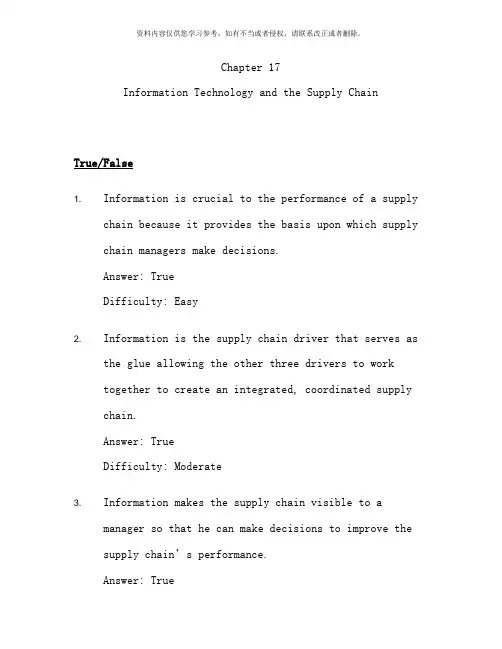
Chapter 17Information Technology and the Supply ChainTrue/False1. Information is crucial to the performance of a supplychain because it provides the basis upon which supply chain managers make decisions.Answer: TrueDifficulty: Easy2. Information is the supply chain driver that serves asthe glue allowing the other three drivers to worktogether to create an integrated, coordinated supplychain.Answer: TrueDifficulty: Moderate3. Information makes the supply chain visible to amanager so that he can make decisions to improve thesupply chain’s performance.Answer: TrueDifficulty: Moderate4. Information is not necessary for management to makedecisions over a broad scope that crosses bothfunctions and companies.Answer: TrueDifficulty: Easy5. Information must be 100 percent correct in order tomake good decisions.Answer: FalseDifficulty: Moderate6. To make good decisions, a manager needs to haveaccurate information regardless of how long it takes to acquire it.Answer: FalseDifficulty: Hard7. Often companies will have large amounts of data thatare not helpful with decision making.Answer: TrueDifficulty: Moderate8. Information is only a key ingredient at each stage ofthe supply chain, not within each phase of supplychain decision making.Answer: FalseDifficulty: Moderate9. The driver of IT in the supply chain has increasinglybeen the enterprise software developed to enableprocesses both within and across companies.Answer: TrueDifficulty: Moderate10. The unsuccessful categories of software will be thosefocused on the supply chain macro processes.Answer: FalseDifficulty: Easy11. This broadening of scope across which companies makedecisions emphasizes the importance of includingprocesses all along the supply chain when makingdecisions.Answer: TrueDifficulty: Moderate12. To increase the supply chain surplus (and thereforetheir firm’s own profitability) most effectively,firms must focus primarily on improving internalprocesses.Answer: FalseDifficulty: Moderate13. Functional performance is important to customersbecause it provides them with capabilities to create a competitive advantage.Answer: TrueDifficulty: Moderate14. The ability to integrate is important to a customerbecause applications that are easy to integrate aregenerally harder to get implemented and producingvalue.Answer: FalseDifficulty: Moderate15. Firms that work well with implementation partners andbuild up large groups of customers trained on theirsolutions have built a highly defensible position.Answer: TrueDifficulty: Moderate16. The goal of the CRM macro process is to negotiate aneffective contract that establishes parameters for asupplier in a way that best meets enterprise needs.Answer: FalseDifficulty: Hard17. Weakness in the CRM process results in demand beinglost and a poor customer experience because orders are not processed and executed effectively.Answer: TrueDifficulty: Easy18. CRM processes are crucial to the supply chain becauseof the lack of interaction between an enterprise andits customers.Answer: False。
供应链产品第三版习题答案供应链产品第三版习题答案在供应链管理领域,供应链产品是非常重要的一环。
通过供应链产品的学习和实践,可以帮助我们更好地理解供应链的运作机制和管理方法。
为了帮助读者更好地掌握供应链产品的知识,本文将提供供应链产品第三版习题的答案,并对其中一些重要的问题进行深入讨论。
第一章:供应链管理概述1. 什么是供应链管理?答案:供应链管理是指通过有效的协调和控制,将原材料供应商、制造商、分销商和最终用户连接在一起,以实现产品从生产到消费的全过程管理。
它包括供应商选择、采购、生产计划、物流管理等方面。
2. 为什么供应链管理对企业至关重要?答案:供应链管理可以帮助企业降低成本、提高效率、提升客户满意度和竞争力。
通过优化供应链,企业可以更好地满足客户需求,提供高质量的产品和服务,并实现可持续发展。
第二章:供应链战略规划1. 什么是供应链战略规划?答案:供应链战略规划是指企业在制定供应链战略时所进行的规划活动。
它包括制定供应链目标、确定供应链策略、设计供应链网络等方面。
2. 供应链战略规划的重要性是什么?答案:供应链战略规划可以帮助企业确定供应链的长期发展方向,提高企业的竞争力和市场地位。
它可以帮助企业更好地应对市场变化,降低供应链风险,并提高供应链的效率和灵活性。
第三章:供应链设计与优化1. 什么是供应链设计?答案:供应链设计是指根据企业的需求和目标,设计供应链的结构和流程。
它包括确定供应链的组织结构、选择供应链合作伙伴、设计供应链流程等方面。
2. 如何进行供应链优化?答案:供应链优化可以通过优化供应链流程、改进供应链合作伙伴关系、提高供应链信息系统的效率等方式来实现。
此外,供应链优化还需要不断地进行监控和评估,以确保优化效果的持续性。
第四章:供应链执行与控制1. 什么是供应链执行?答案:供应链执行是指按照供应链计划和要求,进行供应链活动的实施和管理。
它包括供应商管理、采购管理、生产计划执行、物流管理等方面。
》》》》》》》》》》》》供应链设计与管理——概念、战略与案例研究(第3版)《《《《《《《《《《《《《(选译)第一章1.纵向一体化的企业拥有、管理并运作所有相关的业务职能。
横向一体化的企业由一些独立运营的企业组成,公司总部提供品牌、指导和一般战略。
比较并对比这两种类型企业的供应链战略。
答:纵向一体化企业旨在加强公司各业务成分之间的互动,而且经常集中地管理它们。
这样的结构,可以更容易地通过中央决策除去供应链中的不同部分之间的冲突来实现系统的整体目标。
在横向一体化公司,协调公司内部各业务的供应链通常是没有效益的。
事实上,如果横向一体化企业中的每个企业都专注于它的核心功能,并以最佳状态运行,就可能达到总体的全局最优效果。
2.如果一个企业是完全纵向一体化的,有效供应链管理是否仍然重要?答:有效供应链管理对于完全纵向一体化的公司仍然重要。
在这样的组织结构,公司的不同部门负责不同业务,通常它们都有自己的内部目标,而这些目标有时是无关联的。
这可能是由于缺乏部门之间的沟通或高层的激励政策。
比如,如果只依据收益来评估销售部门, 只依据成本来评估制造部门,公司的总体利润就难以达到最大化。
有效的供应链管理在全局最优业务操作中仍是必要的。
3.考虑一个企业重新设计其物流网络。
为数不多的几个集中仓库的优点是什么?大量靠近最终用户的仓库的优点是什么?答:少数位于市中心的仓库,允许公司利用风险分担,以提高服务水平并降低库存水平和成本。
不过,对外运输成本通常较高,交货间隔期较长。
另一方面,企业可以通过建立更多的靠近最终用户的仓库,以减少对外运输成本和交货间隔期。
然而,这种类型的系统将会使总库存水平和成本增加、规模经济下降、仓储费用增加,并且可能增加对内运输费用。
4.考虑一个企业选择运输服务提供商。
使用卡车承运商的优点是什么?使用诸如UPS这样的包裹速递公司的优点是什么?答:企业对运输服务的选择在很大程度上取决于公司要运输的产品的类型和大小,库存和交付的策略,以及对灵活性的需求:1.如果是大量而稳定的从仓库到需求点(店)运送大件物品或小件物品,货车运输会更好。
同步测试一、单项选择题1、企业的战略一般分为3个层次,分别是企业总体战略、()和职能战略AA、竞争战略B、成本战略C、价格战略D、采购战略2、PESTL分析包括政治环境分析、经济环境分析、社会文化环境分析、技术环境分析、法律环境分析,这些分析能够使采购方通过对()判断,从而帮助企业进行战略决策。
CA、中观环境B、微观环境C、宏观环境D、企业环境3、()是指企业通过降低自己的生产和经营成本,以低于竞争对手的产品价格,获得市场占有率,并获得同行业平均水平以上的利润。
AA、成本领先战略B、差异化战略C、集中化战略D、横向一体化战略4、顾客需求有差异、技术变革很快、企业有很强的市场营销能力,这时企业合选择()战略。
AA、差异化战略B、集中化战略C、成本领先战略D、撤退战略5、()就是从企业战略的高度来对供应链进行全局性规划,它确定原材料的获取和运输,产品的制造或服务的提供,以及产品配送和售后服务的方式与特点。
DA、竞争战略B、采购战略C、营销战略D、供应链战略6、在产品的引入阶段,产品的需求非常不稳定,企业需要建立(),也就是需要对不稳定的需求做出快速反应。
DA、全面性供应链战略B、低成本型供应链战略C、盈利型供应链战略D、反应型供应链战略7、采购战略和()有着本质的不同,采购战略是战略层面,是职能战略范畴,而()是策略层面,它立足于企业的战略目标,以提高组织核心竞争力为目标,采取积极主动的采购活动,并对企业内部资源和外部资源进行整合。
A A、战略采购B、集中采购C、分散采购D、共同采购8、在供应链管理的“销、产、供”模式下,采购活动是以()的方式进行的,整条供应链的采购与供应都是围绕着市场的需求运转。
CA、产品拉动生产B、盈利拉动生产C、订单拉动生产D、物流拉动生产9、在供应链环境下,供应商与生产企业从一般的短期买卖关系发展成长期合作伙伴关系直至()。
CA、战略伙伴关系B、合作关系C、战略协作伙伴关系D、共赢关系10、一般情况功能性产品,供应链追求的应当是()。
专科物流专业供应链管理练习题姓名学号班级练习题一1. 供应链运行绩效的评估A.涉及到的是供应链上的部分企业 B.涉及到了供应链上所有的企业;C.只涉及到核心企业 D.只与上下游企业之间有关系;2.下列不属于供应链环境管理下的库存问题的是A、侧重于优化单一的库存成本B、供应链的战略与规划问题C、供应链的运作问题D、信息类问题3.不属于产品生命周期的是哪个A.计划期B.成长期C.成熟期D.衰退期4.供应链合作伙伴关系的主要目的是A.缩短采购提前期,提高供货的柔性B.加快资金周转C.通过缩短供应链总周期,达到降低成本和提高质量的目的D.减少供应商数目5.指超越一家一户的以一个社会为范畴面向社会为目的的物流;A. 宏观物流B.社会物流C. 微观物流D.企业物流6.下列不属于QR对厂商的优点的是A. 更好的为顾客服务B. 降低了费用C. 生产计划准确D.增加了收入7、下列不是供应链特性的是A.供应链是交错链状的网络结构;B.供应链是企业的主体部分;C.供应链是一条增值链;D.供应链的网络结构是由顾客需求拉动的;8、属于多级库存优化与控制的方法有A.减少成本B.中心化集中式策略C.改进服务质量D.获得更多的市场信息9.TOC理论对供应链的启迪是企业的经营业绩应该是加强链条中 ;A.最强的一环 B.最薄弱的一环C.所有环节D.部分环节10. 建立战略合作关系的第一步必须明确战略关系对于企业的必要性,企业必须评估潜在的A、利益与风险B、成本与风险C、资金与风险D、投资与风险11. 下列不属于供应链环境管理下的库存问题的是A、侧重于优化单一的库存成本B、供应链的战略与规划问题C、供应链的运作问题D、信息类问题12.供应链管理中提到的客户主要是指A、只是指最终的消费者B、与企业内部的部门无关C、可以指代供应链上的每个相关企业和部门D、只指代渠道分销员13.对于供应链下库存管理的方法,以下说法正确的是A、联合库存管理比供应商管理库存的方式更优越B、制造商管理库存体现了战略供应商联盟的新型合作企业合作关系C、联合库存管理体现了战略供应商联盟的新型企业合作关系D、自动库存补充方法体现了战略供应商联盟的新型企业合作关系14.在大多数的跨国公司中,选择供应商的基本准则“Q.C.D.S.”是A、质量、成本、交付与服务并重的原则B、数量、成本、交付与服务并重的原则C、价格、质量、成本与服务并重的原则D、质量、价格、成本与服务并重的原则15.供应链管理的初级阶段,典型的供应链策略主要是指A、企业资源计划与准是制B、高效客户响应和准是制;C、高效客户响应和快速响应D、企业资源计划与快速响应;16.稳定的供应链指的是A、基于相对稳定、单一的市场需求而组成的供应链B、供应链的容量能满足用户需求时的供应链C、体现供应链的市场中介功能D、基于相对频繁变化、复杂的需求组成的动态供应链17.第三方物流服务的成功因素中最主要的是 ;A.可靠性 B.准时性C.快捷性 D.为客户服务18.由供方与需方以外的物流企业提供物流服务的业务模式是 ; A.内部物流 B.第一方物流C.第三方物流 D.军事物流19.目前的供应链系统正在朝着的方向进行改革;A.拉式市场 B.推式市场C.产品中心 D.推拉式市场20.中,会导致“牛鞭效应”;A.拉式市场 B.推式市场C.产品中心 D.推拉式市场1. 物流系统具有特性;A.整体性 B.层次性C.相关性 D.目的性 E.适应性2、供应链管理的作用有哪些A.创造竞争的成本优势B. 创造竞争的收益优势C.创造竞争的时间和空间优越D.创造竞争的整体优势3、基于产品的供应链设计时需考虑的因素有A.产品需求的不确定性B.储存产品仓库的不确定性C.供应链的反应能力D.资金4、供应链的结构模型主要有A、链状的结构模型B、直线型结构模型C、网状的结构模型D、曲线型结构模型5、供应链管理下的采购特点有哪些A.从市场购买转变为外部厂家直接购买B.从采购管理转变转变为外部资源管理C.从为库存而采购转变为为订单而采购D.从一般的买卖关系转变为战略伙伴关系6、供应链的生产外包管理内容包括A.产品价格B.交货数量C.产品质量D.交货期及服务7.绿色供应链的内容包括 ;A.绿色设计 B.绿色采购C.绿色生产 D.绿色物流 E.绿色营销8.横向一体化管理模式的特征有A.生产的核心化B.市场的易扩张化C.组织的柔性化D.利益的多赢化9.有效顾客响应的实现包括的主要信息技术有A.EDI技术B.条码技术C.POS技术D.射频技术10.业务流程重组的类型有A.职能内BPRB.职能间BPRC.组织间BPR C.供应链间的BPR三、名词解释20分,每题2分1.供应链2.供应链管理3.价值链4.延迟技术5.ECR6.CPFR7.牛鞭效应8.安全库存9.联合管理库存10.CRM1、供应链结构模式比一般单个企业的结构模式更为简单;2、依据相对于顾客需求的执行顺序,供应链上的所有流程可以分为两类:推动流程和拉动流程;3、供应链管理的实施目标之一是总成本最低化,总成本最低化目标是指运输费用或库存成本;4、供应链之间的竞争实质上是时间竞争;5、供应商在供应链上扮演着一个至关重要的角色,是链中物流的始发点,是资金流的开始,同时又是反馈信息流的终点;6、第四方物流是第三方物流公司为其客户提供一种增值服务,主要是解决物流规划功能外包问题的物流方案.7、从系统开发的角度,客户关系管理是帮助企业以一定的组织方式来管理客户的互联网软件系统;8、MC模式的关键是实现产品标准化和制造柔性化之间的平衡;9、连续性检查的固定订货量、固定订货点策略,即Q, R策略;该策略的基本思想是:对库存进行连续性检查,当库存降低到订货点水平R时,即发出一个订货,每次的订货量要发生变化;10、联合库存管理Joint Managed Inventory,JMI是指由供应商和用户联合管理库存;五、简答题30分,每题6分1.绿色供应链管理和传统的供应链管理的区别体现在哪些方面2.纵向一体化管理模式存在哪些弊端3. 供应链中需求变异放大产生的原因是什么4. 解释零库存的概念和内涵;5. 准时化采购的特点是什么六、案例分析题10分西南仓储公司的管理西南仓储公司是一家地处四川省成都市的国有商业储运公司,随着市场经济的深入发展,原有的业务资源逐渐减少,在企业的生存和发展过程中,也经历了由专业储运公司到非专业储运公司再到专业储运公司的发展历程;在业务资源和客户资源不足的情况下,这个以仓储为主营业务的企业其仓储服务是有什么就储存什么;以前是以五金交电为主,后来也储存过钢材、水泥和建筑涂料等生产资料;这种经营方式解决了企业仓库的出租问题;那么,这家企业是如何发展区域物流的呢专业化当仓储资源又重新得到充分利用的时候,这家企业并没有得到更多利益,经过市场调查和分析研究,这家企业最后确定了立足自己的老本行,发展以家用电器为主的仓储业务;一方面,在家用电器仓储上,加大投入和加强管理,加强与国内外知名家用电器厂商的联系,向这些客户和潜在客户介绍企业确定的面向家用电器企业的专业化发展方向,吸引家电企业进入;另一方面,与原有的非家用电器企业用户协商,建议其转库,同时将自己的非家用电器用户主动地介绍给其他同行;延伸服务在家用电器的运输和使用过程中,不断出现损坏的家用电器,以往,每家生产商都是自己进行维修,办公场所和人力方面的成本很高,经过与用户协商,在得到大多数生产商认可的情况下,这家企业在库内开始了家用电器的维修业务,既解决了生产商的售后服务的实际问题,也节省了维修品往返运输的成本和时间,并分流了企业内部的富余人员,一举两得;多样化除了为用户提供仓储服务之外,这家企业还为一个最大的客户提供办公服务,向这个客户的市场销售部门提供办公场所,为客户提供了前店后厂的工作环境,大大的提高了客户的满意度;区域性物流配送通过几年的发展,企业经营管理水平不断提高,企业内部的资源得到了充分的挖掘,同样,企业的仓储资源和其他资源也已经处于饱和状态,资源饱和了,收入的增加从何而来在国内发展现代物流的形势下,这家企业认识到只有走出库区,走向社会,发展物流,才能提高企业的经济效益,提高企业的实力;发展物流从何处做起经过调查和分析,决定从学习入手,向比自己先进的企业学习,逐步进入现代物流领域;经过多方努力,他们找到一家第三方物流企业,在这个第三方物流企业的指导下,通过与几家当地的运输企业合作外包运输,开始了区域内的家用电器物流配送,为一家跨国公司提供物流服务,现在这家企业的家用电器的物流配送已经覆盖了四川成都市、贵州和云南;问题:1通过案例分析说明现代物流与传统物流的区别2通过分析西南仓储公司向现代物流的转变过程,你认为其转变成功的关键是什么3通过本案例分析,你认为中国目前传统物流企业怎样才能实现向现代物流的转变练习题二一.单选题20分,每题1分1. 要体现供应链的物理功能,即以最低的成本将原材料转化成零部件、半成品、产品,以及在供应链中的运输等;A、有效性供应链B、反应性供应链C、稳定供应链D、动态供应链2.企业已经普遍将信息系统业务,在规定的服务水平基础上外包给应用服务提供商ASP,由其管理并提供用户所需要的信息服务;这是属于业务方式;A、研发外包B、生产外包C、脑力资源外包D、应用服务外包3. 不是供应链管理环境下采购的特点;A、为订单而采购B、从采购管理向外部资源管理转变C、为库存而采购D、从一般买卖关系向战略协作伙伴关系转变4.求变异加速放大的原因中, 需求放大的主要原因;A、需求预测修正B、订货批量决策C、价格波动D、短缺博弈5.企业目前工作流程存在的问题中,是由于分工过细造成的问题是A、无人负责整个经营过程,缺乏全心全意为顾客服务的意识B、组织机构臃肿,助长官僚作风C、单一,适应性差D、资源闲置和重复劳动,症结是内部信息纵向和横向沟通不够6.在物流管理组织结构的演变中,试图在一个高层经理的领导下,统一所有的物流功能和运作,目的是对所有原材料和制成品的运输和存储进行战略管理,以使企业产生最大利益;这种组织基本上是属于A、传统物流管理组织结构B、简单功能集合的物流组织形式C、物流功能独立的组织形式D、一体化物流组织形式7.CR系统的构建中的在零售环节, 是管理的重点;A、营销技术B、物流技术C、信息技术D、组织革新技术8.dEx参与电子商务业务的主要身份是A.经营者 B.制造者 C.网站经营者 D.第三方物流9.流服务与成本的关系中,大部分企业普遍存在和被公认的关系是A.在物流服务水平一定的情况下,降低物流成本;B.在提高物流服务水平的同时,增加了物流成本;C.在物流成本一定的情况下,提高了物流服务水平;D.在提高服务水平的同时,降低物流成本;10.决定每一种商品的恰当库存水平,以及维持这些库存水平的恰当策略是A.JITB.EOQC.VMID.QR11.流的主要特点是前端服务与_____集成;A.后端服务B. 外包服务C.物流服务D.客户服务12.JIT技术又称及时管理方式,也称零库存管理方式,该技术是由以下哪个汽车公司开发出来的A.日本丰田B.德国福特C.日本本田D.美国通用13.联合库存管理作为一种合作创新的管理模式,更多地体现在A.供需协调管理B.机制建立C.信息沟通D.需求预测14.ECR的主要目标是A. 增加供应链各个环节的收益B. 降低供应链各个环节的成本C. 缩短供应链各个环节的时间D. 提高了供应链各个环节的服务15.管理最主要的两个领域就是供应商的选择和A. 供应商的关系管理B. 供应商的目标管理C. 供应商的成本管理D. 供应商的考核管理16.价值链的概念是迈克尔.波特在其著名的一书中提出的;A. 竞争优势B.竞争战略C. 国家竞争力D.竞争力17. 供应链管理这个名词最早出现在A、交通运输业B、城市配送业C、信息产业D、咨询业18. 供应链合作伙伴关系的主要目的是A.缩短采购提前期,提高供货的柔性B.加快资金周转C.通过缩短供应链总周期,达到降低成本和提高质量的目的D.减少供应商数目19. 指超越一家一户的以一个社会为范畴面向社会为目的的物流;A. 宏观物流B.社会物流C. 微观物流D.企业物流20.不属于QR对厂商的优点的是A. 更好的为顾客服务B. 降低了费用C. 生产计划准确D.增加了收入二.多选题10分,每题1分1、下列体现了供应链管理的管理思想A、强调核心竞争力B、资源外用OutsourcingC、合作性竞争D、延迟制造Postponement原则;E、以顾客满意度为目标的服务化管理;2、供应链设计的主要内容有A、供应链成员及合作伙伴选择B、网络结构设计C、供应链运行基本规则D、协调机制E、生产物流的计划与控制体系的建立3、核心竞争力的主要特点是A、价值优越性B、难替代性C、差异性D、可延伸性E、可复制性4、根据计划来管理企业的生产经营活动,叫做计划管理,计划管理是一个过程,通常包括阶段;A、编制计划B、执行计划C、检查计划完成情况D、组织E、制定改进措施5、供应链管理环境下的生产计划与传统生产计划有显著的不同;在制定生产计划的过程中,主要面临以下方面的问题;A、柔性约束B、生产进度C、生产能力D、组织设计E、物流管理6、需求变异加速放大的原因 ;A、需求预测修正B、订货批量决策C、多级库存D、短缺博弈E、价格波动7、VMI的基本思想有A、联合进行管理库存B、使双方成本最小互惠原则C、框架协议目标一致性原则D、连续改进原则E、合作精神合作性原则8、第三方物流公司的未来前景可以向以下方面努力;A、老主顾外包其他业务B、实施联合运输方式C、开发物流信息管理系统D、处理供应链末端任务E、整合供应链作业9、下列在供应链管理中的应用比较广泛;A、Internet/Intranet技术、WEB技术B、MRP、MRPII 、ERP、CRM、JIT、CIMSC、CAD/CAMD、BR、RFID、GIS、GPS、EDIE、航空航天技术10、CPFR的主要特点有 ;A、协同B、规划C、预测D、战略E、补货三、名词解释10分,每题2分1.第三方物流2.JIT采购3.零和关系4.EDI5.物流一体化四、判断题10分,每题1分1.所谓供应链的合作伙伴关系,也就是供应链中各节点企业之间的关系,对制造业来说,主要是制造商与制造商之间的关系;2.哈兰德Harland将供应链管理描述成对商业活动和组织内部关系、与直接采购者的关系、与第一级或第二级供应商的关系、与客户的关系等整个供应链关系的管理;3.供应链环境下,以团队工作为特征的组织模式使供应链具有网络化结构特征,因此供应链管理模式不是层级管理,也不是矩阵管理,而是网络化管理; 4.为了支持企业内部集成化供应链管理,主要采用供应链计划Supply Chain Planning, SCP和JIT来实施集成化计划和控制;5.从节点企业与节点企业之间关系的角度来考察,供应链网络结构主要包括链状结构、网状结构、核心企业网状结构三种;6.当存在外部性时,企业应尽可能的集中布局,这样可以获得更多的收益利润,攫取最大可能的市场份额;7.即时制采购是一种先进的采购模式,它的基本思想是:在恰当的时间、恰当的地点、以恰当的数量、恰当的质量提供恰当的物品;8.决策树是一种图谱,它可用来评估存在不确定因素的情况下所作出的决策;但对供应链内部评估弹性时,决策树分析方法却并不十分有效;9.CRM是一种以客户为中心的商业哲学、商业战略和企业文化;10.单个企业绩效评价指标主要是基于业务流程的绩效评价指标,而供应链绩效评价指标是基于部门职能的绩效评价指标;五、简答题30分,每题3分1.述基于供应链的运输决策的要点有哪些2.信息技术对供应链管理有哪些影响3.如何对供应商进行评估和选择4.简述供应链设计的原则和步骤;5. 实施客户关系管理的战略步骤;6.简述供应链网状模型;7.订货点法的库存管理策略包括哪几种8.供应链管理环境下供应商管理库存VMI的优势是什么9.物流外包的阻力和风险是什么10.有效顾客响应的实施战略有哪些六、论述题20分,每题10分1. 论述企业如何进行业务外包活动;2. 供应链合作关系与传统供应商关系有什么不同14级专科物流专业供应链管理练习题答案习题一一、单选题1-5 BAACA 6-10 CABBA11-15 ACCAC 16-20 ADCAB二、多选题1 ABCDE2 ABD3 BCD4 AC5 ABCD6 ABCD7 ABCDE8 ABCD9 AC 10 ABC三、略书本能直接找到答案四、判断题1-5×√×√√ 6-10√×√√√五、略书本能直接找到答案六、案例分析参考答案答: 1答:基于现代供应链管理理念的物流;将现代信息技术应用到全过程;以社会化运作的第三方物流为主;2答:市场分析,要求进入物流市场切入点,发展自己优势,充分利用社会资源,减少进入成本,提高服务水平,拓展服务功能;3答:调整市场、自身优势、结合点、外部资源、管理机制习题二一、单选题1-5 CDCDD 6-10 DCDDC11-15 ACABA 16-20 ADCAC二、多选题1 CDE2 ABCD3 ABCD4 ABCDE5 ACD6 DE7 ABCDE8 BCDE9 ABD 10 ABCE三、略书本能直接找到答案四、判断题1-5×√√×√ 6-10×√×√×五、略书本能直接找到答案六、论述题1. 1研发外包研发外包是利用外部资源弥补自己开发能力的不足;企业可以根据需要,有选择地和相关研究院所、大专院校建立合作关系,将技术项目“外包”给他们攻关,或购买先进的但尚未产业化的技术;2生产外包这种外包一般是企业将生产环节安排到劳动力成本较低的国家,以降低生产环节的成本;3物流外包物流外包不仅仅降低了企业的整体运作成本,更重要的是使买卖过程摆脱了物流过程的束缚,使供应链能够为客户提供前所未有的服务;4脑力资源外包即雇用外界的人力主要是脑力资源,解决本企业解决不了或解决不好的问题;脑力资源外包内容主要有互联网咨询、信息管理、ERP系统实施应用、管理;2. 供应链合作关系与传统供应商关系有什么不同答:在新的竞争环境下,供应链合作关系强调长期的战略协作,强调共同努力实现共有的计划和解决共同问题,强调的是相互之间的信任与合作;这与传统的关系模式有着很大的区别,见下表;供应链合作关系与传统供应商关系的比较。
Chapter 2Supply Chain Performance: Achieving Strategic Fit and ScopeTrue/False1. A company’s competitive strategy defines the set of customer needs that it seeksto satisfy through its products and services.Answer: TrueDifficulty: Easy2. The value chain emphasizes the close relationship between all the functionalstrategies within a company.Answer: TrueDifficulty: Moderate3. A company’s product development strategy defines the set of customer needs that itseeks to satisfy through its products and services.Answer: FalseDifficulty: Moderate4. A company’s product development strategy specifies the portfolio of new productsthat it will try to develop.Answer: TrueDifficulty: Easy5. A company’s supply chain strategy specifies how the market will b e segmentedand how the product will be positioned, priced, and promoted.Answer: FalseDifficulty: Easy6. A company’s supply chain strategy determines the nature of procurement andtransportation of materials as well as the manufacture and distribution of the product.Answer: TrueDifficulty: Easy7. The degree of supply chain responsiveness should be consistent with the implieduncertainty.Answer: TrueDifficulty: Easy8. The degree of supply chain responsiveness does not need to be consistent with theimplied uncertainty.Answer: FalseDifficulty: Moderate9. To achieve complete strategic fit, a firm must ensure that all functions in the valuechain have consistent strategies that support the competitive strategy.Answer: TrueDifficulty: Moderate10. To achieve complete strategic fit, a firm must ensure that all functions in the valuechain have diverse strategies that support functional goals.Answer: FalseDifficulty: Moderate11. Because demand and supply characteristics change, the supply chain strategy mustchange over the product life cycle if a company is to continue achieving strategic fit.Answer: TrueDifficulty: Easy12. The supply chain strategy must be established at the beginning of the product lifecycle and not changed if a company is to continue achieving strategic fit.Answer: FalseDifficulty: Easy13. To retain strategic fit, supply chain strategy must be adjusted over the life cycle of aproduct and as the competitive landscape changes.Answer: TrueDifficulty: Moderate14. The intercompany scope of strategic fit is essential today because the competitiveplaying field has shifted from company versus company to supply chain versussupply chain.Answer: TrueDifficulty: Moderate15. The intercompany scope of strategic fit is no longer relevant today because thecompetitive playing field has shifted from company versus company to supply chain versus supply chain.Answer: FalseDifficulty: Easy16. The intercompany scope of strategic fit requires firms to evaluate every action in thecontext of the entire supply chain.Answer: TrueDifficulty: Moderate17. There is a close connection between the design and management of supply chainflows and the success of a supply chain.Answer: TrueDifficulty: EasyMultiple Choice1. A company’s competitive strategya. defines the set of customer needs that it seeks to satisfy through itsproducts and services.b. specifies the portfolio of new products that it will try to develop.c. specifies how the market will be segmented and how the product will bepositioned, priced, and promoted.d. determines the nature of procurement and transportation of materials aswell as manufacture and distribution of the product.e. determines how it will obtain and maintain the appropriate set of skills andabilities to meet customer needs.Answer: aDifficulty: Moderate2. A company’s product development strategya. defines the set of customer needs that it seeks to satisfy through itsproducts and services.b. specifies the portfolio of new products that it will try to develop.c. specifies how the market will be segmented and how the product will bepositioned, priced, and promoted.d. determines the nature of procurement and transportation of materials aswell as manufacture and distribution of the product.e. determines how it will obtain and maintain the appropriate set of skills andabilities to meet customer needs.Answer: bDifficulty: Easy3. A company’s marketing and sales strategya. defines the set of customer needs that it seeks to satisfy through itsproducts and services.b. specifies the portfolio of new products that it will try to develop.c. specifies how the market will be segmented and how the product will bepositioned, priced, and promoted.d. determines the nature of procurement and transportation of materials aswell as manufacture and distribution of the product.e. determines how it will obtain and maintain the appropriate set of skills andabilities to meet customer needs.Answer: cDifficulty: Moderate4. A company’s supply chain strategya. defines the set of customer needs that it seeks to satisfy through itsproducts and services.b. specifies the portfolio of new products that it will try to develop.c. specifies how the market will be segmented and how the product will bepositioned, priced, and promoted.d. determines the nature of procurement and transportation of materials aswell as manufacture and distribution of the product.e. determines how it will obtain and maintain the appropriate set of skills andabilities to meet customer needs.Difficulty: Easy5. Which of the following determines the nature of procurement of raw materials,transportation of materials to and from the company, manufacture of the product or operation to provide the service, and distribution of the product to the customer along with follow-up service?a. Competitive strategyb. Product development strategyc. Marketing and sales strategyd. Supply chain strategye. none of the aboveAnswer: dDifficulty: Easy6. Which of the following defines the set of customer needs that a company seeks tosatisfy through its products and services?a. Competitive strategyb. Product development strategyc. Marketing and sales strategyd. Supply chain strategye. none of the aboveAnswer: aDifficulty: Moderate7. Which of the following specifies how the market will be segmented and how theproduct will be positioned, priced, and promoted?a. Competitive strategyb. Product development strategyc. Marketing and sales strategyd. Supply chain strategye. none of the aboveAnswer: cDifficulty: Moderate8. Which of the following specifies the portfolio of new products that a company will tryto develop?a. Competitive strategyb. Product development strategyc. Marketing and sales strategyd. Supply chain strategye. all of the aboveAnswer: bDifficulty: Easy9. A supply chain strategy includesa. supplier strategy.b. operations strategy.c. logistics strategy.d. all of the abovee. none of the aboveDifficulty: Moderate10. A supply chain strategy involves decisions regardinga. inventory.b. transportation.c. operating facilities.d. information flows.e. all of the aboveAnswer: eDifficulty: Moderate11. A supply chain strategy involves decisions regarding all of the following excepta. inventory.b. transportation.c. new product development.d. operating facilities.e. information flows.Answer: cDifficulty: Moderate12. Which of the following is a key to the success or failure of a company?a. The competitive strategy and all functional strategies must fit together toform a coordinated overall strategy.b. Each functional strategy must support other functional strategies and helpa firm reach its competitive strategy goal.c. The different functions in a company must appropriately structure theirprocesses and resources to be able to execute strategies successfully.d. All of the above are keys to success.e. None of the above are a key to success.Answer: dDifficulty: Moderate13. Which of the following is not a key to the success or failure of a company?a. The competitive strategy and all functional strategies must fit together to forma coordinated overall strategy.b. Each functional strategy must support other functional strategies and help afirm reach its competitive strategy goal.c. The different functions in a company must appropriately structure theirprocesses and resources to be able to execute strategies successfully.d. All of the above are keys to success.e. None of the above are a key to success.Answer: dDifficulty: Moderate14. Which of the following is not a key to the success or failure of a company?a. The competitive strategy and all functional strategies must fit together toform a coordinated overall strategy.b. The competitive strategy and all functional strategies operateindependently of each other.c. The different functions in a company must appropriately structure theirprocesses and resources to be able to execute strategies successfully.d. Each functional strategy must support other functional strategies and helpa firm reach its competitive strategy goal.e. All of the above are keys to success.Answer: bDifficulty: Moderate15. Which of the following are basic steps to achieving strategic fit?a. Understanding the customer and supply uncertainty.b. Understanding the supply chain capabilities.c. Achieving strategic fit.d. All of the above are basic steps to achieving strategic fit.e. None of the above are a basic step to achieving strategic fit.Answer: dDifficulty: Moderate16. Which of the following is not a basic step to achieving strategic fit?a. Achieving strategic fit.b. Understanding the supply chain capabilities.c. Determining the response time that customers are willing to tolerate.d. Understanding the customer and supply uncertainty.e. none of the aboveAnswer: cDifficulty: Moderate17. Customer demand from different segments varies along which of the followingattributes?a. The quantity of product needed in each lot.b. The response time that customers are willing to tolerate.c. The variety of products needed.d. The service level required.e. all of the aboveAnswer: eDifficulty: Easy18. Which of the following is not an attribute along which customer demand varies?a. The uniqueness of the product.b. The quantity of product needed in each lot.c. The variety of products needed.d. The desired rate of innovation in the product.e. All of the above are attributes.Answer: aDifficulty: Moderate19. The uncertainty of customer demand for a product is thea. rate of strategic uncertainty.b. demand uncertainty.c. implied demand uncertainty.d. average forecast error.e. none of the aboveAnswer: bDifficulty: Moderate20. The uncertainty that exists due to the portion of demand that the supply chain isrequired to meet is thea. rate of strategic uncertainty.b. demand uncertainty.c. implied demand uncertainty.d. average forecast error.e. none of the aboveAnswer: cDifficulty: Moderate21. Which of the following customer needs will cause implied uncertainty of demand toincrease?a. Range of quantity required increasesb. Lead time decreasesc. Variety of products required increasesd. Required service level increasese. all of the aboveAnswer: eDifficulty: Easy22. Which of the following customer needs will cause implied uncertainty of demand todecrease?a. Range of quantity required increasesb. Lead time decreasesc. Variety of products required increasesd. Required service level increasese. none of the aboveAnswer: eDifficulty: Moderate23. Which of the following customer needs will cause implied uncertainty of demand toincrease?a. Product marginb. Lead time decreasesc. Average stockout rated. Average forced season end markdowne. none of the aboveAnswer: bDifficulty: Moderate24. Which of the following characteristics of customer demand have a correlation withimplied uncertainty?a. Product marginb. Average forecast errorc. Average stockout rated. Average forced season end markdowne. all of the aboveAnswer: eDifficulty: Moderate25. Which of the following is not a characteristic of customer demand correlated withimplied uncertainty?a. Product marginb. Unpredictable and low yieldsc. Average stockout rated. Average forced season end markdowne. None of the above are correlated with implied uncertaintyAnswer: bDifficulty: Moderate26. Which of the following supply chain capabilities will cause supply uncertainty toincrease?a. Frequent breakdownsb. Unpredictable and low yieldsc. Poor qualityd. Limited supply capacitye. all of the aboveAnswer: eDifficulty: Easy27. Which of the following supply chain capabilities will cause supply uncertainty toincrease?a. Evolving production processb. Inflexible supply capacityc. Limited supply capacityd. Unpredictable and low yieldse. all of the aboveAnswer: eDifficulty: Easy28. Which of the following supply chain capabilities will cause supply uncertainty todecrease?a. Evolving production processb. Inflexible supply capacityc. Limited supply capacityd. Unpredictable and low yieldse. none of the aboveAnswer: eDifficulty: Moderate29. Which of the following is not a supply chain capability that will impact supplyuncertainty?a. Evolving production processb. Inflexible supply capacityc. Limited supply capacityd. Product margine. Unpredictable and low yieldsAnswer: dDifficulty: Moderate30. The first step in achieving strategic fit between competitive and supply chainstrategies is toa. understand the supply chain and map it on the responsiveness spectrum.b. understand customers and supply chain uncertainty.c. match supply chain responsiveness with the implied uncertainty ofdemand.d. ensure that all functional strategies within the supply chain support thesupply chain’s level of responsiveness.e. none of the aboveAnswer: bDifficulty: Hard31. The second step in achieving strategic fit between competitive and supply chainstrategies is toa. understand the supply chain and map it on the responsiveness spectrum.b. understand customers and supply chain uncertainty.c. match supply chain responsiveness with the implied uncertainty of demand.d. ensure that all functional strategies within the supply chain support the supplychain’s level of responsiveness.e. none of the aboveAnswer: aDifficulty: Hard32. The final step in achieving strategic fit between competitive and supply chainstrategies is toa. understand the supply chain and map it on the responsiveness spectrum.b. understand customers and supply chain uncertainty.c. match supply chain responsiveness with the implied uncertainty of demand.d. combine customer and supply chain uncertainty and map it on the implieduncertainty spectrum.e. all of the aboveAnswer: cDifficulty: Moderate33. Supply chain responsiveness includes the ability to do which of the following?a. Respond to wide ranges of quantities demandedb. Meet short lead timesc. Handle a large variety of productsd. Meet a very high service levele. all of the aboveAnswer: eDifficulty: Easy34. Supply chain responsiveness includes the ability to do which of the following?a. Handle supply uncertaintyb. Build highly innovative productsc. Meet short lead timesd. Meet a very high service levele. all of the aboveAnswer: eDifficulty: Easy35. Supply chain responsiveness includes the ability to do which of the following?a. Handle supply uncertaintyb. Understand customers and supply chain uncertaintyc. Match supply chain responsiveness with the implied uncertainty ofdemandd. Ensure that all functional strategies within the supply chain support thesupply chain’s level of responsivenesse. none of the aboveAnswer: aDifficulty: Moderate36. Supply chain responsiveness includes the ability to do which of the following?a. Understand customers and supply chainb. Meet a very high service levelc. Match supply chain responsiveness with the implied uncertainty of demandd. Ensure that all functional strategies within the supply chain support the supplychain’s level of responsive nesse. none of the aboveAnswer: bDifficulty: Moderate37. Supply chain responsiveness includes the ability to do which of the following?a. Understand customers and supply chainb. Match supply chain responsiveness with the implied uncertainty of demandc. Meet short lead timesd. Ensure that all functional strategies within the supply chain support the supplychain’s level of responsivenesse. all of the aboveAnswer: cDifficulty: Moderate38. The cost of making and delivering a product to the customer is referred to asa. supply chain responsiveness.b. supply chain efficiency.c. cost-responsiveness efficient frontier.d. implied uncertainty.e. none of the aboveAnswer: bDifficulty: Easy39. The curve that shows the lowest possible cost for a given level of responsiveness isreferred to as thea. supply chain responsiveness curve.b. supply chain efficiency curve.c. cost-responsiveness efficient frontier.d. responsiveness spectrum.e. none of the aboveAnswer: cDifficulty: Moderate40. A firm that is not on the cost-responsiveness efficient frontier can improvea. both responsiveness and cost performance.b. only responsiveness.c. only cost performance.d. responsiveness, but not cost performance.e. neither responsiveness nor cost performance.Answer: aDifficulty: Easy41. A firm that is not on the cost-responsiveness efficient frontier can improvea. both responsiveness and cost performance.b. only responsiveness.c. only cost performance.d. either responsiveness or cost performance, but not both.e. neither responsiveness nor cost performance.Answer: aDifficulty: Moderate42. A firm that is on the cost-responsiveness efficient frontier can improvea. responsiveness only by increasing cost and becoming less efficient.b. cost performance only by reducing responsiveness.c. both responsiveness and cost performance by improving processes andchanging technology to shift the efficient frontier.d. all of the abovee. neither responsiveness nor cost performance.Answer: dDifficulty: Moderate43. A graph with two axes with implied uncertainty along the horizontal axis andresponsiveness along the vertical axis is referred to as thea. implied uncertainty spectrum.b. responsiveness spectrum.c. uncertainty/responsiveness map.d. zone of strategic fit.e. none of the aboveAnswer: cDifficulty: Moderate44. The relationship where increasing implied uncertainty from customers and supplysources is best served by increasing responsiveness from the supply chain is known as thea. implied uncertainty spectrum.b. responsiveness spectrum.c. uncertainty/responsiveness map.d. zone of strategic fit.e. none of the aboveAnswer: dDifficulty: Moderate45. To achieve complete strategic fit, a firm musta. consider all functional strategies within the value chain.b. ensure that all functions in the value chain have consistent strategies thatsupport the competitive strategy.c. ensure that all substrategies within the supply chain such asmanufacturing, inventory, and purchasing be consistent with the supplychain’s level of responsiveness.d. all of the abovee. none of the aboveAnswer: dDifficulty: Hard46. The drive for strategic fit should come froma. the supply chain manager.b. the strategic planning department.c. the highest levels of the organization, such as the CEO.d. middle management.e. sales and marketing.Answer: cDifficulty: Hard47. The important points to remember about achieving strategic fit area. there is one best supply chain strategy for all competitive strategies.b. there is no right supply chain strategy independent of the competitivestrategy.c. there is a right supply chain strategy for a given competitive strategy.d. all of the abovee. b and c onlyAnswer: eDifficulty: Hard48. The preferable supply chain strategy for a firm that sells multiple products and servescustomer segments with very different needs is toa. set up independent supply chains for each different product or customersegment.b. set up a supply chain that meets the needs of the highest volume productor customer segment.c. tailor the supply chain to best meet the needs of each product’s demand.d. set up a supply chain that meets the needs of the customer segment withthe highest implied uncertainty.e. set up a supply chain that meets the needs of product with the highestimplied uncertainty.Answer: cDifficulty: Hard49. Which of the following would not be a demand and supply characteristic toward thebeginning stages of a product’s life cycle?a. Demand is very uncertain and supply may be unpredictable.b. Demand has become more certain and supply is predictable.c. Margins are often high and time is crucial to gaining sales.d. Product availability is crucial to capturing the market.e. Cost is often of secondary consideration.Answer: bDifficulty: Moderate50. Which of the following would be a demand and supply characteristic toward thebeginning stages of a product’s life cycle?a. Demand has become more certain and supply is predictable.b. Margins are lower due to an increase in competitive pressure.c. Product availability is crucial to capturing the market.d. Price becomes a significant factor in customer choice.e. none of the aboveAnswer: cDifficulty: Moderate51. Which of the following would not be a demand and supply characteristic in the laterstages of a product’s life cycle?a. Demand has become more certain and supply is predictable.b. Margins are lower due to an increase in competitive pressure.c. Product availability is crucial to capturing the market.d. Price becomes a significant factor in customer choice.e. All of the above are characteristics of the later stages.Answer: cDifficulty: Moderate52. The functions and stages that devise an integrated strategy with a shared objectiveare referred to asa. competitive strategy.b. supply chain strategy.c. scope of strategic fit.d. scope of marketing strategy.e. scope of product development strategy.Answer: cDifficulty: Moderate53. The most limited scope over which strategic fit is considered is one operation withina functional area in a company. This is referred to asa. intracompany intraoperational scope.b. intracompany intrafunctional scope.c. intracompany interoperational scope.d. intercompany interfunctional scope.e. agile intercompany scope.Answer: aDifficulty: Easy54. The scope of strategic fit that includes all operations within a function in a companyisa. intracompany intraoperational scope.b. intracompany intrafunctional scope.c. intracompany interoperational scope.d. intercompany interfunctional scope.e. agile intercompany scope.Answer: bDifficulty: Easy55. The scope of strategic fit where all functional strategies are developed to supportboth each other and the competitive strategy in order to maximize company profit isa. intracompany intraoperational scope.b. intracompany intrafunctional scope.c. intracompany interoperational scope.d. intercompany interfunctional scope.e. agile intercompany scope.Answer: cDifficulty: Easy56. The scope of strategic fit that requires that each company evaluate its actions in thecontext of the entire supply chain isa. intracompany intraoperational scope.b. intracompany intrafunctional scope.c. intracompany interoperational scope.d. intercompany interfunctional scope.e. agile intercompany scope.Answer: dDifficulty: Easy57. A firm’s ability to achieve strategic fit when partnering with supply chain stages th atchange over time is referred to asa. intracompany intraoperational scope.b. intracompany intrafunctional scope.c. intracompany interoperational scope.d. intercompany interfunctional scope.e. agile intercompany scope.Answer: eDifficulty: EasyEssay/Problems1. Discuss the two keys to the success or failure of a company.Answer: A company’s success or failure is thus closely linked to the followingkeys:1. The competitive strategy and all functional strategies must fit together to forma coordinated overall strategy. Each functional strategy must support otherfunctional strategies and help a firm reach its competitive strategy goal.2. The different functions in a company must appropriately structure theirprocesses and resources to be able to execute these strategies successfully.Difficulty: Hard2. List and explain the three basic steps to achieving strategic fit.Answer: There are three basic steps to achieving strategic fit:1. Understanding the customer and supply chain uncertaint y. First a companymust understand the customer needs for each targeted segment and theuncertainty the supply chain faces in satisfying these needs. These needs helpthe company define the desired cost and service requirements. The supply chain uncertainty helps the company identify the extent of disruption and delay thesupply chain must be prepared for.2. Understanding the supply chain capabilities. There are many types of supplychains, each of which is designed to perform different tasks well. A companymust understand what its supply chain is designed to do well.3. Achieving strategic fit. If a mismatch exists between what the supply chaindoes particularly well and the desired customer needs, the company will eitherneed to restructure the supply chain to support the competitive strategy or alterits strategy.Difficulty: Moderate3. List the attributes along which customer demand from different segments canvary.Answer: In general, customer demand from different segments may vary alongseveral attributes as follows:∙The quantity of the product needed in each lot∙The response time that customers are willing to tolerate∙The variety of products needed∙The service level required∙The price of the product∙The desired rate of innovation in the productDifficulty: Moderate4. List the abilities included in supply chain responsiveness.Answer: Supply chain responsiveness includes a supply chain’s ability to do the following:∙Respond to wide ranges of quantities demanded∙Meet short lead times∙Handle a large variety of products∙Build highly innovative products∙Meet a very high service level∙Handle supply uncertaintyDifficulty: Moderate5. Discuss the impact of the product life cycle on strategic fit between implieddemand uncertainty and supply chain responsiveness.Answer: As products go through their life cycle, the demand characteristics and the needs of the customer segments being served change. Supplycharacteristics also change as the product and production technologies mature.High-tech products are particularly prone to these life cycle swings over a verycompressed time span. A product goes through life cycle phases from theintroductory phase, when only the leading edge of customers is interested in itand supply is uncertain, all the way to the point at which the product becomes a。